Tutorial for analyzing instrumental learning data with the HDDMrl module
This is a tutorial for using the HDDMrl module to simultaneously estimate reinforcement learning parameters and decision parameters within a fully hierarchical bayesian estimation framework, including steps for sampling, assessing convergence, model fit, parameter recovery, and posterior predictive checks (model validation). The module uses the reinforcement learning drift diffusion model (RLDDM), a reinforcement learning model that replaces the standard “softmax” choice function with a drift diffusion process. The softmax and drift diffusion process is equivalent for capturing choice proportions, but the DDM also takes RT distributions into account; options are provided to also only fit RL parameters without RT. The RLDDM estimates trial-by-trial drift rate as a scaled difference in expected rewards (expected reward for upper bound alternative minus expected reward for lower bound alternative). Expected rewards are updated with a delta learning rule using either a single learning rate or with separate learning rates for positive and negative prediction errors. The model also includes the standard DDM-parameters. The RLDDM is described in detail in Pedersen, Frank & Biele (2017). (Note this approach differs from Frank et al (2015) who used HDDM to fit instrumental learning but did not allow for simultaneous estimation of learning parameters).
OUTLINE
1. Background 2. Installing the module 3. How the RLDDM works 4. Structuring data 5. Running basic model 6. Checking results 7. Posterior predictive checks 8. Parameter recovery 9. Separate learning rates for positive and negative prediction errors10. depends_on vs. split_by 11. Probabilistic binary outcomes vs. normally distributed outcomes12. HDDMrlRegressor 13. Regular RL without RT
1. Background
Traditional RL models typically assume static decision processes (e.g. softmax), and the DDM typically assumes static decision variables (stimuli are modeled with the same drift rate across trials). The RLDDM combines dynamic decision variables from RL and dynamic choice process from DDM by assuming trial-by-trial drift rate that depends on the difference in expected rewards, which are updated on each trial by a rate of the prediction error dependent on the learning rate. The potential benefit of the RLDDM is thus to gain a better insight into decision processes in instrumental learning by also accounting for speed of decision making.
2. Installing the module
The new version of HDDM (version 0.7.1) that includes the RLDDM is currently not uploaded to conda. So to install you would either have to use pip: ‘pip install hddm’ OR docker: ‘pull madslupe/hddm’, which runs hddm in jupyter notebook
3. How the RLDDM works
The main idea of the RLDDM is that reward-based choices can be captured by an accumulation-to-bound process where drift rate is proportional to the difference in expected reward between options, and where expected rewards subsequently are updated in a trial-by-trial basis via reinforcement learning. drift rate on each trial depends on difference in expected rewards for the two alternatives (q_up and q_low): drift rate = (q_up - q_low) * scaling where the scaling parameter describes the weight to put on the difference in q-values. expeceted reward (q) for chosen option is updated according to delta learning rule : q_chosen = q_chosen + alpha * (feedback-q_chosen) where alpha weights the rate of learning on each trial. So in principle all you need is the Wiener first passage time likelihood-function. The reason why HDDM is useful (and hence also HDDMrl) is that it automates the process of setting up and running your model, which tends to be very time consuming. So after structuring the data it is simple to run a model with HDDMrl. In particular it separates subjects and conditions (using the split_by-column, see next section) so that the updating process works correctly, which can be especially difficult to do for RL models.
4. Structuring data
The HDDMrl module was created to make it easier to model instrumental learning data with the RLDDM. If you are familiar with using HDDM it shouldn’t be a big step to start using HDDMrl. Please refresh your memory by starting with the tutorial for HDDM first (especially critical if you have not used HDDM at all). Running HDDMrl does require a few extra steps compared to HDDM, and because the model includes increased potential for parameter colinearity (typically learning rate and the scaling parameter on drift rate) it is even more important to assess model fit, which will be covered below. Here are the most important steps for structuring your dataframe: 1. Sort trials in ascending order within subject and condition, to ensure proper updating of expected rewards. 2. Include a column called ‘split_by’ which identifies the different task conditions (as integers), to ensure reward updating will work properly for each condition without mixing values learned from one trial type to another. 3. Code the response column with [stimulus-coding] (http://ski.clps.brown.edu/hddm_docs/howto.html#code-subject-responses). Although stimulus-coding and accuracy-coding often are the same in instrumental learning it is important that the upper and lower boundaries are represented by the same alternative within a condition, because expected rewards are linked to the thresholds/boundaries. 4. feedback-column. This should be the reward received for the chosen option on each trial. 5. q_init. Adjusting initial q-values is something that can improve model fit quite a bit. To allow the user to set their own initial values we therefore require that the dataframe includes a column called q_init. The function will set all initial q-values according to the first value in q_init. So this is not the most elegant method of allowing users to set inital value for expected rewards, but it works for now.
Required columns in data:
rt: in seconds, same as in HDDM
response: 0 or 1. defines chosen stimulus, not accuracy.
split_by: needs to be an integer. Split_by defines conditions (trial-types) that should have the same variables (e.g. Q values) within subject: the trials need to be split by condition to ensure proper updating of expected rewards that do not bleed over into other trial-types. (e.g. if you have stimulus A and get reward you want that updated value to impact choice only for the next stimulus A trial but not necessarily the immediate trial afterwards, which may be of a different condition)
subj_idx: same as in HDDM, but even more important here because it is used to split trials
feedback: feedback on the current trial. can be any value.
q_init: used to initialize expected rewards. can be any value, but an unbiased initial value should be somewhere between the minimum and and maximum reward values (e.g. 0.5 for tasks with rewards of 0 and 1).
5. Running basic model
To illustrate how to run the model we will use example data from the learning phase of the probabilistic selection task (PST). During the learning phase of the PST subjects choose between two stimuli presented as Hiragana-letters (here represented as letters from the latin alphabet). There are three conditions with different probabilities of receiving reward (feedback=1) and non-reward (feedback=0). In the AB condition A is rewarded with 80% probability, B with 20%. In the CD condition C is rewarded with 70% probability and D with 30%, while in the EF condition E is rewarded with a 60% probability and F with 40%. The dataset is included in the data-folder in your installation of HDDM.
# import
import pandas as pd
import numpy as np
import hddm
from scipy import stats
import seaborn as sns
import matplotlib.pyplot as plt
import pymc
import kabuki
sns.set(style="white")
%matplotlib inline
from tqdm import tqdm
import warnings
warnings.filterwarnings("ignore", category=np.VisibleDeprecationWarning)
/Users/madslundpedersen/anaconda/envs/py36/lib/python3.6/site-packages/IPython/parallel.py:13: ShimWarning: The IPython.parallel package has been deprecated since IPython 4.0. You should import from ipyparallel instead. "You should import from ipyparallel instead.", ShimWarning)
# load data. you will find this dataset in your hddm-folder under hddm/examples/rlddm_data.csv
data = hddm.load_csv("rlddm_data.csv")
# check structure
data.head()
| subj_idx | response | cond | rt | trial | split_by | feedback | q_init | |
|---|---|---|---|---|---|---|---|---|
| 0 | 42 | 0.0 | CD | 1.255 | 1.0 | 1 | 0.0 | 0.5 |
| 1 | 42 | 1.0 | EF | 0.778 | 1.0 | 2 | 0.0 | 0.5 |
| 2 | 42 | 1.0 | AB | 0.647 | 1.0 | 0 | 1.0 | 0.5 |
| 3 | 42 | 1.0 | AB | 0.750 | 2.0 | 0 | 1.0 | 0.5 |
| 4 | 42 | 0.0 | EF | 0.772 | 2.0 | 2 | 1.0 | 0.5 |
The columns in the datafile represent: subj_idx (subject id), response (1=best option), cond (identifies condition, but not used in model), rt (in seconds), 0=worst option), trial (the trial-iteration for a subject within each condition), split_by (identifying condition, used for running the model), feedback (whether the response given was rewarded or not), q_init (the initial q-value used for the model, explained above).
# run the model by calling hddm.HDDMrl (instead of hddm.HDDM for normal HDDM)
m = hddm.HDDMrl(data)
# set sample and burn-in
m.sample(1500, burn=500, dbname="traces.db", db="pickle")
# print stats to get an overview of posterior distribution of estimated parameters
m.print_stats()
[-----------------100%-----------------] 1500 of 1500 complete in 151.7 sec mean std 2.5q 25q 50q 75q 97.5q mc err
a 1.75114 0.0837255 1.59815 1.69574 1.74802 1.80376 1.92983 0.00291067
a_std 0.41232 0.0656654 0.308913 0.367279 0.405368 0.447927 0.56776 0.00289675
a_subj.3 2.00788 0.102676 1.82598 1.93802 2.00144 2.07171 2.23154 0.00493845
a_subj.4 1.89902 0.0536733 1.8001 1.86271 1.89701 1.93338 2.00713 0.00230884
a_subj.5 1.48871 0.0715107 1.35642 1.43919 1.4863 1.53484 1.63991 0.00325001
a_subj.6 2.40214 0.0937021 2.22399 2.33902 2.40306 2.46714 2.58429 0.00398112
a_subj.8 2.50645 0.143083 2.24263 2.39808 2.50384 2.60774 2.78264 0.00698664
a_subj.12 1.90226 0.0674087 1.77675 1.8556 1.89957 1.94815 2.04225 0.00320297
a_subj.17 1.40972 0.0847752 1.22943 1.35608 1.40973 1.4647 1.58511 0.00491962
a_subj.18 1.91654 0.124726 1.67828 1.83025 1.90977 1.99927 2.18669 0.00673609
a_subj.19 2.08417 0.0794147 1.93045 2.03586 2.07986 2.13421 2.24956 0.00371623
a_subj.20 1.71138 0.0843558 1.54864 1.65762 1.71167 1.76404 1.88942 0.00415579
a_subj.22 1.19208 0.0324851 1.13197 1.17101 1.19101 1.21212 1.26011 0.00145357
a_subj.23 1.93444 0.102446 1.74689 1.86325 1.92864 1.99758 2.15107 0.00503582
a_subj.24 1.69065 0.0895549 1.53553 1.62691 1.68709 1.7483 1.87742 0.0040531
a_subj.26 2.23017 0.0812178 2.08111 2.17227 2.22704 2.2827 2.39238 0.00361254
a_subj.33 1.56584 0.069505 1.43544 1.52022 1.56458 1.61061 1.70839 0.00293951
a_subj.34 1.82111 0.0925344 1.63987 1.75834 1.81963 1.88833 1.99193 0.00392129
a_subj.35 1.83364 0.0910862 1.66166 1.77008 1.83076 1.89022 2.02515 0.00434047
a_subj.36 1.32831 0.0711046 1.19866 1.27959 1.32398 1.3726 1.4815 0.00326779
a_subj.39 1.57092 0.0570179 1.46831 1.53323 1.56933 1.60591 1.69108 0.00254816
a_subj.42 1.72289 0.0780534 1.58344 1.6716 1.71808 1.77379 1.8881 0.003965
a_subj.50 1.46373 0.0561168 1.36497 1.42376 1.46046 1.50046 1.5824 0.00367163
a_subj.52 2.12277 0.0877004 1.9546 2.06291 2.11955 2.17823 2.3141 0.00422443
a_subj.56 1.47434 0.0491814 1.38212 1.44175 1.47195 1.50692 1.57668 0.00236224
a_subj.59 1.30969 0.0844833 1.1589 1.24941 1.31109 1.36849 1.48692 0.00618501
a_subj.63 1.87185 0.0892341 1.71495 1.80829 1.86594 1.93234 2.06417 0.00389064
a_subj.71 1.24574 0.0337506 1.18058 1.22069 1.24465 1.2673 1.31452 0.00144168
a_subj.75 0.980626 0.0403033 0.90314 0.954133 0.978959 1.00467 1.06114 0.00181344
a_subj.80 2.19842 0.0996843 2.00149 2.13232 2.19346 2.26375 2.39521 0.00447729
v 4.15839 0.799926 2.70281 3.61434 4.11883 4.69384 5.82079 0.0512965
v_std 3.17944 0.582619 2.24768 2.73327 3.12028 3.57136 4.51764 0.0380689
v_subj.3 5.40933 2.40655 1.26099 3.71918 5.11575 6.79629 11.0188 0.186314
v_subj.4 0.935868 0.13627 0.687918 0.84222 0.929464 1.02821 1.21449 0.00574671
v_subj.5 5.53473 2.53813 1.29287 3.73108 5.17908 7.11548 11.2961 0.172848
v_subj.6 5.07554 2.29577 1.82701 3.34519 4.68917 6.43253 10.5485 0.187447
v_subj.8 3.19083 1.1531 1.76428 2.43081 2.9948 3.64642 6.33461 0.087577
v_subj.12 1.80427 0.222639 1.40465 1.65858 1.796 1.93888 2.27892 0.00974675
v_subj.17 7.71563 2.30556 3.88888 6.02563 7.55031 9.12299 12.7238 0.182644
v_subj.18 6.87545 1.94651 3.83483 5.50429 6.56637 8.00345 11.3874 0.15955
v_subj.19 11.8954 2.02558 8.68551 10.3678 11.7157 13.1091 16.4924 0.149489
v_subj.20 4.80234 1.28635 2.96684 3.93358 4.52135 5.36143 8.30574 0.109046
v_subj.22 2.21094 0.293277 1.62874 2.02192 2.20417 2.41537 2.7777 0.0132941
v_subj.23 2.8458 1.98089 0.960886 1.48088 2.03871 3.77161 8.22177 0.174202
v_subj.24 5.15582 0.764892 3.67864 4.64563 5.15715 5.65935 6.65519 0.0285252
v_subj.26 0.539671 0.59661 0.254778 0.404612 0.480991 0.553289 0.877278 0.0407894
v_subj.33 2.77334 2.13257 0.295247 1.13338 2.15707 4.00407 8.14233 0.12317
v_subj.34 4.20132 2.39341 1.17239 2.25712 3.63896 5.72171 9.86739 0.177777
v_subj.35 3.17444 1.95745 1.12509 1.74651 2.53013 4.17782 8.26337 0.165034
v_subj.36 3.79907 2.4476 1.36971 2.15898 2.87502 4.67084 10.8683 0.21156
v_subj.39 2.27064 1.97675 0.351198 0.93656 1.50589 3.11784 7.49375 0.1472
v_subj.42 5.47322 2.08405 2.49925 3.95688 5.08889 6.58481 10.7829 0.18176
v_subj.50 5.70079 2.01626 2.97595 4.19379 5.32492 6.75934 10.6905 0.167811
v_subj.52 2.56559 1.27486 1.14649 1.72739 2.22896 3.00905 5.93314 0.103506
v_subj.56 1.87343 1.94759 0.212418 0.6233 1.10997 2.31925 7.51623 0.148776
v_subj.59 11.2906 1.94818 7.97466 9.83034 11.1653 12.6626 15.1351 0.14348
v_subj.63 2.05387 1.17635 0.989297 1.45023 1.76468 2.2066 5.22357 0.0898511
v_subj.71 2.32088 1.91716 0.634099 1.10631 1.53357 2.8856 7.62118 0.163783
v_subj.75 3.76763 0.515318 2.81054 3.40891 3.73677 4.11781 4.78664 0.0226513
v_subj.80 4.15577 2.33956 0.982954 2.46786 3.77248 5.33636 10.1362 0.175881
t 0.434731 0.0449488 0.349777 0.402709 0.432116 0.465472 0.530516 0.00202517
t_std 0.236392 0.0433431 0.169573 0.204342 0.230946 0.263389 0.335781 0.00225172
t_subj.3 1.06328 0.0269397 1.00059 1.04824 1.06656 1.08227 1.10795 0.00125471
t_subj.4 0.527271 0.0172907 0.490716 0.515989 0.527876 0.53992 0.557357 0.000658754
t_subj.5 0.527646 0.014447 0.496233 0.518696 0.528208 0.53814 0.554243 0.000635292
t_subj.6 0.397077 0.0299213 0.336127 0.377453 0.400033 0.418076 0.450114 0.0012808
t_subj.8 0.658242 0.0471014 0.555228 0.629207 0.663679 0.69109 0.739203 0.00230504
t_subj.12 0.409272 0.0138971 0.380402 0.399887 0.409665 0.419001 0.435401 0.0006559
t_subj.17 0.498748 0.0187879 0.465868 0.489276 0.498427 0.505531 0.561609 0.00129853
t_subj.18 0.434937 0.0272817 0.376619 0.418105 0.439607 0.455449 0.477842 0.00145894
t_subj.19 0.419517 0.0147876 0.388266 0.410812 0.420257 0.429526 0.447385 0.000714105
t_subj.20 0.516323 0.0130322 0.48754 0.508106 0.517514 0.524971 0.539053 0.000629322
t_subj.22 0.335449 0.00512245 0.324519 0.33239 0.335702 0.338995 0.34542 0.000217804
t_subj.23 0.481071 0.0256616 0.421632 0.467006 0.483806 0.498627 0.520986 0.00132232
t_subj.24 0.453832 0.0134345 0.427156 0.445554 0.454765 0.463269 0.477105 0.000596106
t_subj.26 0.444783 0.0328836 0.374369 0.423034 0.451583 0.469492 0.495256 0.00151257
t_subj.33 0.195056 0.016176 0.162122 0.185433 0.195017 0.205708 0.226932 0.000650143
t_subj.34 0.343165 0.0315926 0.271023 0.327582 0.343388 0.361161 0.412591 0.00137201
t_subj.35 0.32677 0.0242391 0.277956 0.311416 0.326512 0.340882 0.378627 0.00110084
t_subj.36 0.446884 0.0144441 0.412717 0.440513 0.450059 0.456836 0.467726 0.000633566
t_subj.39 0.618878 0.01217 0.595016 0.611293 0.619984 0.626443 0.641677 0.000581635
t_subj.42 0.393969 0.0156021 0.360875 0.385018 0.394406 0.405246 0.420589 0.000713536
t_subj.50 0.52176 0.020651 0.482413 0.50144 0.530288 0.538845 0.548235 0.00142198
t_subj.52 0.514314 0.0241081 0.464691 0.500631 0.515679 0.528825 0.562804 0.0010807
t_subj.56 0.117367 0.010816 0.0938512 0.110853 0.118345 0.124671 0.13743 0.000534744
t_subj.59 0.380717 0.023454 0.333847 0.363709 0.378302 0.403572 0.415476 0.00188964
t_subj.63 0.476737 0.0209237 0.427639 0.465293 0.478463 0.490654 0.513883 0.000911725
t_subj.71 0.162961 0.00548919 0.150952 0.159712 0.163301 0.166739 0.172795 0.000229584
t_subj.75 0.260312 0.00688929 0.243917 0.257628 0.261829 0.26465 0.27016 0.000329039
t_subj.80 0.0403546 0.0169699 0.0110397 0.0275679 0.0396382 0.0518146 0.07515 0.000796892
alpha -2.4752 0.38727 -3.27381 -2.72039 -2.46563 -2.22027 -1.73132 0.024173
alpha_std 1.50582 0.28705 1.02513 1.30159 1.47813 1.67341 2.16245 0.0177882
alpha_subj.3 -3.44582 0.761229 -4.50645 -3.90142 -3.5688 -3.16481 -1.1172 0.063098
alpha_subj.4 0.237126 0.613602 -0.794058 -0.17478 0.175653 0.598227 1.7028 0.0264375
alpha_subj.5 -3.40368 0.788364 -4.55092 -3.93851 -3.51397 -3.05458 -1.16324 0.0541566
alpha_subj.6 -3.93563 0.597556 -4.97378 -4.34796 -4.0016 -3.55438 -2.62741 0.0500632
alpha_subj.8 -2.3184 0.608761 -3.68071 -2.6901 -2.27008 -1.89455 -1.26035 0.0450248
alpha_subj.12 -0.713202 0.387328 -1.51458 -0.951136 -0.720293 -0.466909 0.1033 0.0170274
alpha_subj.17 -2.98879 0.456849 -3.78019 -3.28732 -3.03176 -2.73572 -1.96528 0.0365151
alpha_subj.18 -2.91076 0.412397 -3.68444 -3.17673 -2.92772 -2.65501 -2.10694 0.0324668
alpha_subj.19 -3.72053 0.228938 -4.18767 -3.86342 -3.71741 -3.56332 -3.28838 0.0162997
alpha_subj.20 -2.40625 0.434508 -3.33223 -2.69369 -2.38142 -2.12126 -1.53731 0.0357525
alpha_subj.22 -0.994157 0.211281 -1.39653 -1.14136 -0.989873 -0.846522 -0.569635 0.00958114
alpha_subj.23 -2.44627 1.09817 -4.44185 -3.36588 -2.36064 -1.63009 -0.449431 0.0952876
alpha_subj.24 -1.48682 0.224823 -1.9422 -1.62148 -1.48105 -1.34561 -1.0569 0.0074061
alpha_subj.26 0.604183 1.36559 -4.01713 0.185604 0.726365 1.29128 2.58996 0.0988941
alpha_subj.33 -3.23136 1.39147 -5.53349 -4.23992 -3.46426 -2.21955 -0.533487 0.086119
alpha_subj.34 -3.0473 0.91459 -4.56504 -3.74049 -3.17223 -2.40633 -1.11687 0.0676703
alpha_subj.35 -2.69845 0.991454 -4.42691 -3.51339 -2.71695 -1.94905 -0.79832 0.083924
alpha_subj.36 -2.18601 1.08057 -4.18804 -3.01064 -2.13118 -1.3696 -0.219222 0.0888798
alpha_subj.39 -3.19389 1.34091 -5.70502 -4.26935 -3.14082 -2.15396 -0.850496 0.101065
alpha_subj.42 -3.2365 0.58383 -4.28719 -3.64026 -3.23312 -2.83965 -2.0334 0.0511965
alpha_subj.50 -3.80546 0.669532 -4.96325 -4.25891 -3.86233 -3.43775 -2.36238 0.0550394
alpha_subj.52 -2.98914 0.634666 -4.32377 -3.40425 -2.95264 -2.53491 -1.8269 0.0504978
alpha_subj.56 -3.65603 1.46117 -6.20744 -4.73829 -3.64526 -2.63292 -0.808278 0.107188
alpha_subj.59 -2.57749 0.239341 -3.02079 -2.73683 -2.58904 -2.41926 -2.10183 0.0153308
alpha_subj.63 -1.87078 0.918292 -3.93444 -2.37009 -1.78878 -1.27689 -0.298987 0.0646095
alpha_subj.71 -2.94137 1.59686 -5.55049 -4.28727 -2.76687 -1.96191 0.648818 0.127415
alpha_subj.75 -1.41741 0.395315 -2.1895 -1.6736 -1.41537 -1.14351 -0.64445 0.0169447
alpha_subj.80 -3.2501 0.804037 -4.57126 -3.78446 -3.33574 -2.83023 -1.42305 0.0617733
DIC: 10122.571164
deviance: 10056.119971
pD: 66.451192
Interpreting output from print_stats: The model estimates group mean and standard deviation parameters and subject parameters for the following latent variables: a = decision threshold v = scaling parameter t = non-decision time alpha = learning rate, note that it’s not bound between 0 and 1. to transform take inverse logit: np.exp(alpha)/(1+np.exp(alpha)) The columns represent the mean, standard deviation and quantiles of the approximated posterior distribution of each parameter
HDDMrl vs. HDDM
There are a few things to note that is different from the normal HDDM model. First of all, the estimated learning rate does not necessarily fall between 0 and 1. This is because it is estimated as a normal distribution for purposes of sampling hierarchically and then transformed by an inverse logit function to 0<alpha<1. So to interpret alpha as learning rate you have to transform the samples in the trace back with np.exp(alpha)/(1+np.exp(alpha)). And if you estimate separate learning rates for positive and negative prediction errors (see here) then you get learning rate for negative prediction errors with np.exp(alpha)/(1+np.exp(alpha)) and positive prediction errors with np.exp(pos_alpha)/(1+np.exp(pos_alpha)). Second, the v-parameter in the output is the scaling factor that is multiplied by the difference in q-values, so it is not the actual drift rate (or rather, it is the equivalent drift rate when the difference in Q values is exactly 1).
6. Checking results
# plot the posteriors of parameters
m.plot_posteriors()
Plotting a
Plotting a_std
Plotting v
Plotting v_std
Plotting t
Plotting t_std
Plotting alpha
Plotting alpha_std

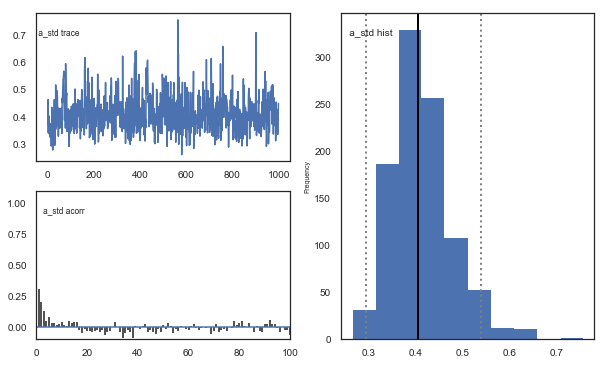
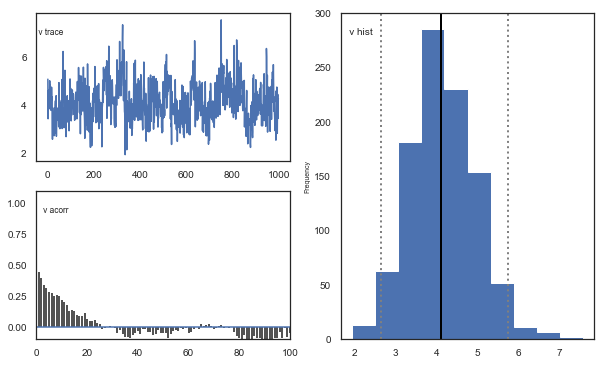
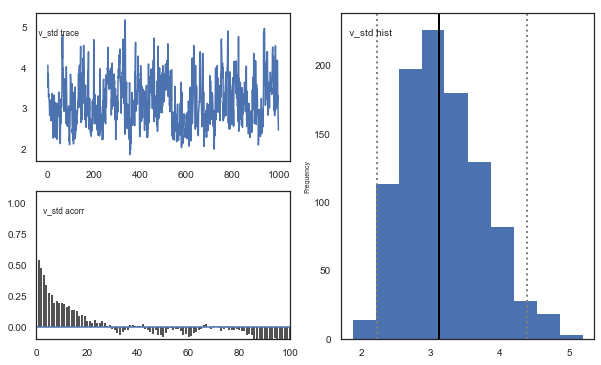
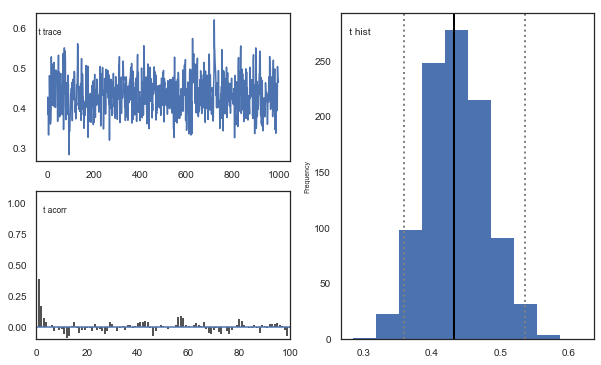
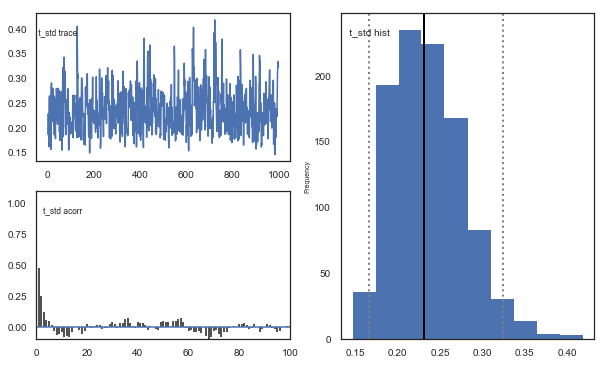
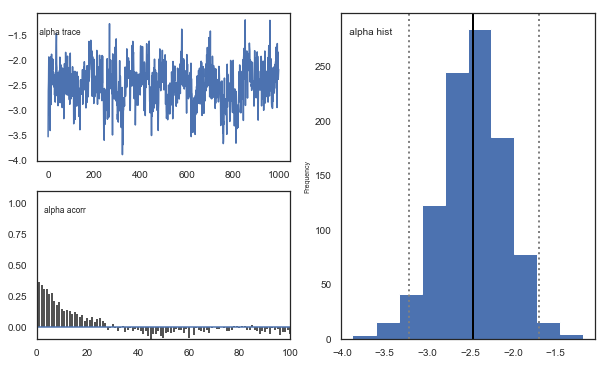
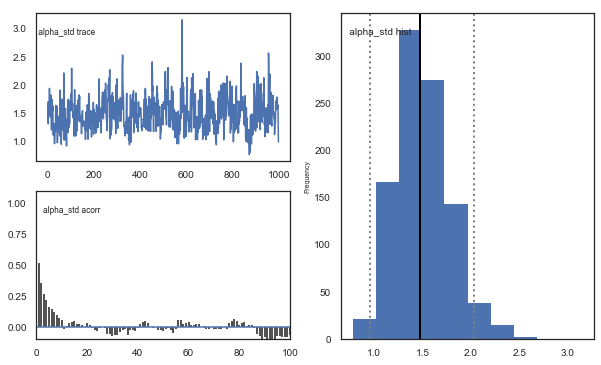
Fig. The mixing of the posterior distribution and autocorrelation looks ok.
Convergence of chains
The Gelman-Rubin statistic is a test of whether the chains in the model converges. The Gelman-Ruben statistic measures the degree of variation between and within chains. Values close to 1 indicate convergence and that there is small variation between chains, i.e. that they end up as the same distribution across chains. A common heuristic is to assume convergence if all values are below 1.1. To run this you need to run multiple models, combine them and perform the Gelman-Rubin statistic:
# estimate convergence
from kabuki.analyze import gelman_rubin
models = []
for i in range(3):
m = hddm.HDDMrl(data=data)
m.sample(1500, burn=500, dbname="traces.db", db="pickle")
models.append(m)
gelman_rubin(models)
[-----------------100%-----------------] 1500 of 1500 complete in 148.3 sec
/Users/madslundpedersen/anaconda/envs/py36/lib/python3.6/site-packages/kabuki/analyze.py:148: FutureWarning:
.ix is deprecated. Please use
.loc for label based indexing or
.iloc for positional indexing
See the documentation here:
http://pandas.pydata.org/pandas-docs/stable/user_guide/indexing.html#ix-indexer-is-deprecated
samples[i,:] = model.nodes_db.ix[name, 'node'].trace()
/Users/madslundpedersen/anaconda/envs/py36/lib/python3.6/site-packages/pandas/core/indexing.py:961: FutureWarning:
.ix is deprecated. Please use
.loc for label based indexing or
.iloc for positional indexing
See the documentation here:
http://pandas.pydata.org/pandas-docs/stable/user_guide/indexing.html#ix-indexer-is-deprecated
return getattr(section, self.name)[new_key]
{'a': 1.0032460874018214,
'a_std': 1.0009841521872085,
'a_subj.3': 1.0004396186849591,
'a_subj.4': 0.9999534502455131,
'a_subj.5': 1.003486683386713,
'a_subj.6': 1.0019388857243001,
'a_subj.8': 1.0011512646603846,
'a_subj.12': 0.999566242847165,
'a_subj.17': 0.9997315595714608,
'a_subj.18': 1.007802746170568,
'a_subj.19': 1.0006648642694451,
'a_subj.20': 0.9997046168477743,
'a_subj.22': 0.999761021617672,
'a_subj.23': 0.999981103582067,
'a_subj.24': 0.9999604239014099,
'a_subj.26': 0.9999505203703547,
'a_subj.33': 1.0000641985256977,
'a_subj.34': 1.0019030857893532,
'a_subj.35': 0.9995619813519606,
'a_subj.36': 1.0009696684307878,
'a_subj.39': 1.0030366187047326,
'a_subj.42': 1.0004536365990904,
'a_subj.50': 1.0009246525621893,
'a_subj.52': 0.9998106391663311,
'a_subj.56': 1.002833217938155,
'a_subj.59': 1.0037497197540834,
'a_subj.63': 0.9999025733097772,
'a_subj.71': 1.0009484787096814,
'a_subj.75': 1.0130098962514307,
'a_subj.80': 0.9996362431035328,
'v': 1.0205809795803613,
'v_std': 1.017843838450935,
'v_subj.3': 1.0084966266683277,
'v_subj.4': 0.9995268898509083,
'v_subj.5': 1.0055342540841103,
'v_subj.6': 1.006091261867606,
'v_subj.8': 1.0363142858648078,
'v_subj.12': 0.9999768301313733,
'v_subj.17': 1.0071442953265444,
'v_subj.18': 1.0091310053160127,
'v_subj.19': 1.025227632557955,
'v_subj.20': 1.0047516808487722,
'v_subj.22': 0.9995696752962354,
'v_subj.23': 1.0207703297420343,
'v_subj.24': 1.0003032086685848,
'v_subj.26': 1.0063047977790485,
'v_subj.33': 1.007422885046991,
'v_subj.34': 1.0000055617828756,
'v_subj.35': 1.004080679982615,
'v_subj.36': 1.025998215179402,
'v_subj.39': 1.0176678234231622,
'v_subj.42': 1.0446533107136062,
'v_subj.50': 1.0162948205722397,
'v_subj.52': 1.0329846199571966,
'v_subj.56': 1.0187113333213196,
'v_subj.59': 1.0013982327012232,
'v_subj.63': 1.0084242116205158,
'v_subj.71': 1.0034722375822482,
'v_subj.75': 1.0011359012034806,
'v_subj.80': 1.0071658884593422,
't': 1.0005057563118305,
't_std': 1.0022540551935895,
't_subj.3': 1.000335111817265,
't_subj.4': 0.9995572720794353,
't_subj.5': 1.0010911542829217,
't_subj.6': 1.0005078503952383,
't_subj.8': 1.000937902509564,
't_subj.12': 1.0002256652751758,
't_subj.17': 1.0036774720777926,
't_subj.18': 1.0057241781128603,
't_subj.19': 1.000598016225987,
't_subj.20': 1.0000045946218536,
't_subj.22': 0.99983171259197,
't_subj.23': 1.0005420765808288,
't_subj.24': 1.0016080999110242,
't_subj.26': 0.999512841375442,
't_subj.33': 0.9998364286694233,
't_subj.34': 1.0000670998014844,
't_subj.35': 0.9996132338974929,
't_subj.36': 1.0042098480709771,
't_subj.39': 1.0006515809595558,
't_subj.42': 1.000771348791104,
't_subj.50': 1.002215744431939,
't_subj.52': 1.001052279977618,
't_subj.56': 1.0017299690798878,
't_subj.59': 1.0046305114183551,
't_subj.63': 0.9995008742263429,
't_subj.71': 1.001174121937735,
't_subj.75': 1.0153800235690629,
't_subj.80': 0.9999996479882802,
'alpha': 1.0117546794208931,
'alpha_std': 1.016548833490214,
'alpha_subj.3': 1.0095453823767975,
'alpha_subj.4': 0.9999967981599148,
'alpha_subj.5': 1.0013067894285956,
'alpha_subj.6': 1.0015822997094852,
'alpha_subj.8': 1.028833703352052,
'alpha_subj.12': 0.999682056083204,
'alpha_subj.17': 1.002551456868468,
'alpha_subj.18': 1.0128686930345914,
'alpha_subj.19': 1.0216644572624185,
'alpha_subj.20': 1.003469044949529,
'alpha_subj.22': 0.9998485992621597,
'alpha_subj.23': 1.0211627966678443,
'alpha_subj.24': 1.0029351365812929,
'alpha_subj.26': 1.0082171167684313,
'alpha_subj.33': 1.0088110869085494,
'alpha_subj.34': 1.000806268244852,
'alpha_subj.35': 0.9997657478647997,
'alpha_subj.36': 1.016349397314595,
'alpha_subj.39': 1.0154377853905259,
'alpha_subj.42': 1.0380447906771046,
'alpha_subj.50': 1.014307146980194,
'alpha_subj.52': 1.0421339866800452,
'alpha_subj.56': 1.0345554568486672,
'alpha_subj.59': 1.0004809998032806,
'alpha_subj.63': 1.0167696837574038,
'alpha_subj.71': 1.0030045474552403,
'alpha_subj.75': 1.000110789496688,
'alpha_subj.80': 1.0061715847351584}
np.max(list(gelman_rubin(models).values()))
1.0446533107136062
The model seems to have converged, i.e. the Gelman-Rubin statistic is below 1.1 for all parameters. It is important to always run this test, especially for more complex models (as with separate learning rates for positive and negative prediction errors). So now we can combine these three models to get a better approximation of the posterior distribution.
# Combine the models we ran to test for convergence.
m = kabuki.utils.concat_models(models)
Joint posterior distribution
Another test of the model is to look at collinearity. If the estimation of parameters is very codependent (correlation is strong) it can indicate that their variance trades off, in particular if there is a negative correlation. The following plot shows there is generally low correlation across all combinations of parameters. It does not seem to be the case for this dataset, but common for RLDDM is a negative correlation between learning rate and the scaling factor, similar to what’s usually observed between learning rate and inverse temperature for RL models that uses softmax as the choice rule (e.g. Daw, 2011).
alpha, t, a, v = m.nodes_db.node[["alpha", "t", "a", "v"]]
samples = {"alpha": alpha.trace(), "t": t.trace(), "a": a.trace(), "v": v.trace()}
samp = pd.DataFrame(data=samples)
def corrfunc(x, y, **kws):
r, _ = stats.pearsonr(x, y)
ax = plt.gca()
ax.annotate("r = {:.2f}".format(r), xy=(0.1, 0.9), xycoords=ax.transAxes)
g = sns.PairGrid(samp, palette=["red"])
g.map_upper(plt.scatter, s=10)
g.map_diag(sns.distplot, kde=False)
g.map_lower(sns.kdeplot, cmap="Blues_d")
g.map_lower(corrfunc)
g.savefig("matrix_plot.png")
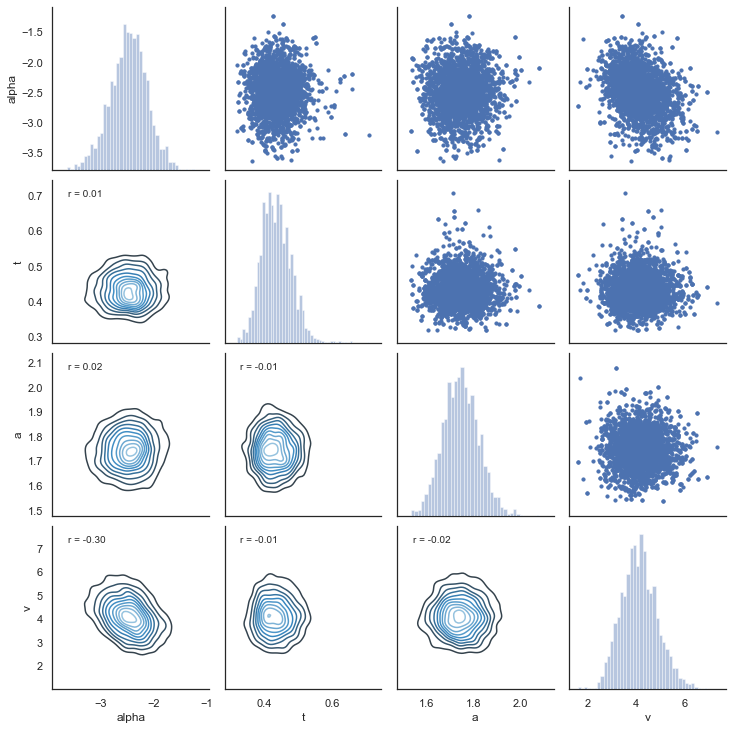
7. Posterior predictive checks
An important test of the model is its ability to recreate the observed data. This can be tested with posterior predictive checks, which involves simulating data using estimated parameters and comparing observed and simulated results.
extract traces
The first step then is to extract the traces from the estimated model. The function get_traces() gives you the samples (row) from the approaximated posterior distribution for all of the estimated group and subject parameters (column).
traces = m.get_traces()
traces.head()
| a | a_std | a_subj.3 | a_subj.4 | a_subj.5 | a_subj.6 | a_subj.8 | a_subj.12 | a_subj.17 | a_subj.18 | ... | alpha_subj.39 | alpha_subj.42 | alpha_subj.50 | alpha_subj.52 | alpha_subj.56 | alpha_subj.59 | alpha_subj.63 | alpha_subj.71 | alpha_subj.75 | alpha_subj.80 | |
|---|---|---|---|---|---|---|---|---|---|---|---|---|---|---|---|---|---|---|---|---|---|
| 0 | 1.663258 | 0.379335 | 1.999766 | 1.964781 | 1.501228 | 2.558870 | 2.134354 | 1.808065 | 1.428145 | 1.904139 | ... | -2.569240 | -2.348125 | -2.279293 | -3.002542 | -2.038603 | -2.255088 | -0.153830 | -1.809325 | -1.738580 | -2.323516 |
| 1 | 1.623170 | 0.359708 | 1.912802 | 1.967012 | 1.462844 | 2.466133 | 2.347265 | 2.031387 | 1.476833 | 1.883079 | ... | -2.593007 | -2.564579 | -2.787299 | -2.817155 | 0.128265 | -2.358720 | -0.709526 | -1.876886 | -1.428454 | -3.140597 |
| 2 | 1.817655 | 0.312626 | 2.013651 | 1.870517 | 1.438784 | 2.332917 | 2.426746 | 2.079006 | 1.264283 | 1.939135 | ... | -3.187908 | -2.566549 | -3.341771 | -3.206621 | -0.724311 | -2.446694 | -1.133453 | -2.153231 | -1.589570 | -2.702218 |
| 3 | 1.762559 | 0.573961 | 1.852805 | 1.920585 | 1.456088 | 2.437470 | 2.679242 | 2.099067 | 1.311264 | 1.902507 | ... | -2.045972 | -2.466571 | -3.093191 | -3.204751 | -3.220443 | -2.381405 | -1.060397 | -1.521510 | -1.892220 | -2.902676 |
| 4 | 1.725824 | 0.472488 | 1.907957 | 1.954045 | 1.462033 | 2.394734 | 2.389626 | 1.928428 | 1.334218 | 1.790217 | ... | -2.035124 | -2.679132 | -3.821553 | -3.372584 | -1.139438 | -2.372234 | -0.895417 | -1.900813 | -2.196233 | -3.063793 |
5 rows × 120 columns
simulating data
Now that we have the traces the next step is to simulate data using the estimated parameters. The RLDDM includes a function to simulate data. Here’s an example of how to use the simulation-function for RLDDM. This example explains how to generate data with binary outcomes. Seeherefor an example on simulating data with normally distributed outcomes. Inputs to function: a = decision threshold t = non-decision time alpha = learning rate pos_alpha = defaults to 0. if given it defines the learning rate for positive prediction errors. alpha then becomes the learning rate_ for negative prediction errors. scaler = the scaling factor that is multiplied with the difference in q-values to calculate trial-by-trial drift rate p_upper = the probability of reward for the option represented by the upper boundary. The current version thus only works for outcomes that are either 1 or 0 p_lower = the probability of reward for the option represented by the lower boundary. subjs = number of subjects to simulate data for. split_by = define the condition which makes it easier to append data from different conditions. size = number of trials per subject.
hddm.generate.gen_rand_rlddm_data(
a=1,
t=0.3,
alpha=0.2,
scaler=2,
p_upper=0.8,
p_lower=0.2,
subjs=1,
split_by=0,
size=10,
)
| q_up | q_low | sim_drift | response | rt | feedback | subj_idx | split_by | trial | |
|---|---|---|---|---|---|---|---|---|---|
| 0 | 0.5000 | 0.50000 | 0.00000 | 1.0 | 0.770 | 1.0 | 0 | 0 | 1 |
| 1 | 0.6000 | 0.50000 | 0.20000 | 0.0 | 0.403 | 0.0 | 0 | 0 | 2 |
| 2 | 0.6000 | 0.40000 | 0.40000 | 0.0 | 0.612 | 0.0 | 0 | 0 | 3 |
| 3 | 0.6000 | 0.32000 | 0.56000 | 0.0 | 0.404 | 1.0 | 0 | 0 | 4 |
| 4 | 0.6000 | 0.45600 | 0.28800 | 1.0 | 0.564 | 1.0 | 0 | 0 | 5 |
| 5 | 0.6800 | 0.45600 | 0.44800 | 1.0 | 0.416 | 1.0 | 0 | 0 | 6 |
| 6 | 0.7440 | 0.45600 | 0.57600 | 0.0 | 0.430 | 0.0 | 0 | 0 | 7 |
| 7 | 0.7440 | 0.36480 | 0.75840 | 0.0 | 0.409 | 0.0 | 0 | 0 | 8 |
| 8 | 0.7440 | 0.29184 | 0.90432 | 1.0 | 0.361 | 1.0 | 0 | 0 | 9 |
| 9 | 0.7952 | 0.29184 | 1.00672 | 1.0 | 0.537 | 0.0 | 0 | 0 | 10 |
How to interpret columns in the resulting dataframe q_up = expected reward for option represented by upper boundary q_low = expected reward for option represented by lower boundary sim_drift = the drift rate for each trial calculated as: (q_up-q_low)*scaler response = simulated choice rt = simulated response time feedback = observed feedback for chosen option subj_idx = subject id (starts at 0) split_by = condition as integer trial = current trial (starts at 1)
Simulate data with estimated parameter values and compare to observed data
Now that we know how to extract traces and simulate data we can combine this to create a dataset similar to our observed data. This process is currently not automated but the following is an example code using the dataset we analyzed above.
from tqdm import tqdm # progress tracker
# create empty dataframe to store simulated data
sim_data = pd.DataFrame()
# create a column samp to be used to identify the simulated data sets
data["samp"] = 0
# load traces
traces = m.get_traces()
# decide how many times to repeat simulation process. repeating this multiple times is generally recommended,
# as it better captures the uncertainty in the posterior distribution, but will also take some time
for i in tqdm(range(1, 51)):
# randomly select a row in the traces to use for extracting parameter values
sample = np.random.randint(0, traces.shape[0] - 1)
# loop through all subjects in observed data
for s in data.subj_idx.unique():
# get number of trials for each condition.
size0 = len(
data[(data["subj_idx"] == s) & (data["split_by"] == 0)].trial.unique()
)
size1 = len(
data[(data["subj_idx"] == s) & (data["split_by"] == 1)].trial.unique()
)
size2 = len(
data[(data["subj_idx"] == s) & (data["split_by"] == 2)].trial.unique()
)
# set parameter values for simulation
a = traces.loc[sample, "a_subj." + str(s)]
t = traces.loc[sample, "t_subj." + str(s)]
scaler = traces.loc[sample, "v_subj." + str(s)]
alphaInv = traces.loc[sample, "alpha_subj." + str(s)]
# take inverse logit of estimated alpha
alpha = np.exp(alphaInv) / (1 + np.exp(alphaInv))
# simulate data for each condition changing only values of size, p_upper, p_lower and split_by between conditions.
sim_data0 = hddm.generate.gen_rand_rlddm_data(
a=a,
t=t,
scaler=scaler,
alpha=alpha,
size=size0,
p_upper=0.8,
p_lower=0.2,
split_by=0,
)
sim_data1 = hddm.generate.gen_rand_rlddm_data(
a=a,
t=t,
scaler=scaler,
alpha=alpha,
size=size1,
p_upper=0.7,
p_lower=0.3,
split_by=1,
)
sim_data2 = hddm.generate.gen_rand_rlddm_data(
a=a,
t=t,
scaler=scaler,
alpha=alpha,
size=size2,
p_upper=0.6,
p_lower=0.4,
split_by=2,
)
# append the conditions
sim_data0 = sim_data0.append([sim_data1, sim_data2], ignore_index=True)
# assign subj_idx
sim_data0["subj_idx"] = s
# identify that these are simulated data
sim_data0["type"] = "simulated"
# identify the simulated data
sim_data0["samp"] = i
# append data from each subject
sim_data = sim_data.append(sim_data0, ignore_index=True)
# combine observed and simulated data
ppc_data = data[
["subj_idx", "response", "split_by", "rt", "trial", "feedback", "samp"]
].copy()
ppc_data["type"] = "observed"
ppc_sdata = sim_data[
["subj_idx", "response", "split_by", "rt", "trial", "feedback", "type", "samp"]
].copy()
ppc_data = ppc_data.append(ppc_sdata)
ppc_data.to_csv("ppc_data_tutorial.csv")
100%|██████████| 50/50 [31:09<00:00, 37.39s/it]
/Users/madslundpedersen/anaconda/envs/py36/lib/python3.6/site-packages/pandas/core/frame.py:7138: FutureWarning: Sorting because non-concatenation axis is not aligned. A future version
of pandas will change to not sort by default.
To accept the future behavior, pass 'sort=False'.
To retain the current behavior and silence the warning, pass 'sort=True'.
sort=sort,
Plotting
Now that we have a dataframe with both observed and simulated data we can plot to see whether the simulated data are able to capture observed choice and reaction times. To capture the uncertainty in the simulated data we want to identify how much choice and reaction differs across the simulated data sets. A good measure of this is to calculate the highest posterior density/highest density interval for summary scores of the generated data. Below we calculate highest posterior density with an alpha set to 0.1, which means that we are describing the range of the 90% most likely values.
# for practical reasons we only look at the first 40 trials for each subject in a given condition
plot_ppc_data = ppc_data[ppc_data.trial < 41].copy()
Choice
# bin trials to for smoother estimate of response proportion across learning
plot_ppc_data["bin_trial"] = pd.cut(
plot_ppc_data.trial, 11, labels=np.linspace(0, 10, 11)
).astype("int64")
# calculate means for each sample
sums = (
plot_ppc_data.groupby(["bin_trial", "split_by", "samp", "type"])
.mean()
.reset_index()
)
# calculate the overall mean response across samples
ppc_sim = sums.groupby(["bin_trial", "split_by", "type"]).mean().reset_index()
# initiate columns that will have the upper and lower bound of the hpd
ppc_sim["upper_hpd"] = 0
ppc_sim["lower_hpd"] = 0
for i in range(0, ppc_sim.shape[0]):
# calculate the hpd/hdi of the predicted mean responses across bin_trials
hdi = pymc.utils.hpd(
sums.response[
(sums["bin_trial"] == ppc_sim.bin_trial[i])
& (sums["split_by"] == ppc_sim.split_by[i])
& (sums["type"] == ppc_sim.type[i])
],
alpha=0.1,
)
ppc_sim.loc[i, "upper_hpd"] = hdi[1]
ppc_sim.loc[i, "lower_hpd"] = hdi[0]
# calculate error term as the distance from upper bound to mean
ppc_sim["up_err"] = ppc_sim["upper_hpd"] - ppc_sim["response"]
ppc_sim["low_err"] = ppc_sim["response"] - ppc_sim["lower_hpd"]
ppc_sim["model"] = "RLDDM_single_learning"
ppc_sim.to_csv("ppc_choicedata_tutorial.csv")
# plotting evolution of choice proportion for best option across learning for observed and simulated data.
fig, axs = plt.subplots(figsize=(15, 5), nrows=1, ncols=3, sharex=True, sharey=True)
for i in range(0, 3):
ax = axs[i]
d = ppc_sim[(ppc_sim.split_by == i) & (ppc_sim.type == "simulated")]
ax.errorbar(
d.bin_trial,
d.response,
yerr=[d.low_err, d.up_err],
label="simulated",
color="orange",
)
d = ppc_sim[(ppc_sim.split_by == i) & (ppc_sim.type == "observed")]
ax.plot(d.bin_trial, d.response, linewidth=3, label="observed")
ax.set_title("split_by = %i" % i, fontsize=20)
ax.set_ylabel("mean response")
ax.set_xlabel("trial")
plt.legend()
fig.savefig("PPCchoice.pdf")
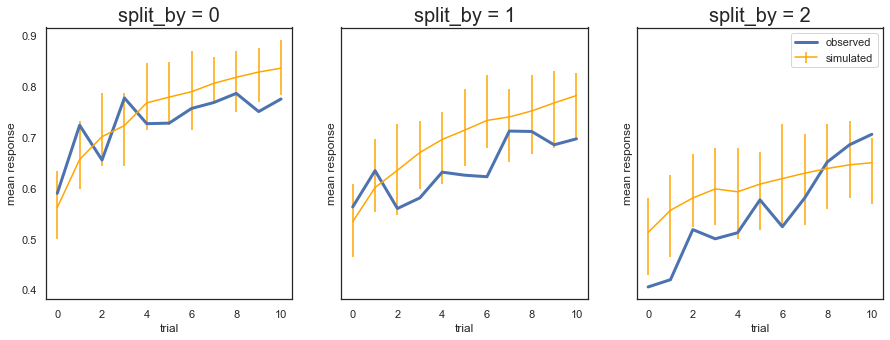
Fig. The plots display the rate of choosing the best option (response = 1) across learning and condition. The model generates data (orange) that closely follows the observed behavior (blue), with the exception of overpredicting performance early in the most difficult condition (split_by=2). Uncertainty in the generated data is captured by the 90% highest density interval of the means across simulated datasets.
RT
# set reaction time to be negative for lower bound responses (response=0)
plot_ppc_data["reaction time"] = np.where(
plot_ppc_data["response"] == 1, plot_ppc_data.rt, 0 - plot_ppc_data.rt
)
# plotting evolution of choice proportion for best option across learning for observed and simulated data. We use bins of trials because plotting individual trials would be very noisy.
g = sns.FacetGrid(plot_ppc_data, col="split_by", hue="type")
g.map(sns.kdeplot, "reaction time", bw=0.05).set_ylabels("Density")
g.add_legend()
g.savefig("PPCrt_dist.pdf")

Fig. Density plots of observed and predicted reaction time across conditions. RTs for lower boundary choices (i.e. worst option choices) are set to be negative (0-RT) to be able to separate upper and lower bound responses.
8. Parameter recovery
To validate the RLDDM we ran a parameter recovery study to test to which degree the model can recover the parameter values used to simulate data. To do this we generated 81 synthetic datasets with 50 subjects performing 70 trials each. The 81 datasets were simulated using all combinations of three plausible parameter values for decision threshold, non-decision time, learning rate and the scaling parameter onto drift rate.
Estimated values split by simulated vales
We can plot simulated together with the estimated values to test the models ability to recover parameters, and to see if there are any values that are more difficult to recover than others.
param_recovery = hddm.load_csv("recovery_sim_est_rlddm.csv")
g = sns.catplot(x="a", y="e_a", data=param_recovery, palette="Set1")
g.set_axis_labels("Simulated threshold", "Estimated threshold")
plt.title("Decision threshold")
g.savefig("Threshold_recovery.pdf")
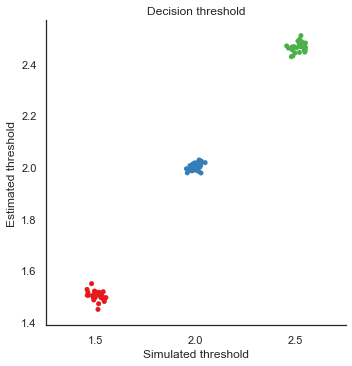
g = sns.catplot(x="alpha", y="e_alphaT", data=param_recovery, palette="Set1")
g.set_axis_labels("Simulated alpha", "Estimated alpha")
plt.title("Learning rate")
g.savefig("Alpha_recovery.pdf")

g = sns.catplot(x="scaler", y="e_v", data=param_recovery, palette="Set1")
g.set_axis_labels("Simulated scaling", "Estimated scaling")
plt.title("Scaling drift rate")
g.savefig("Scaler_recovery.pdf")
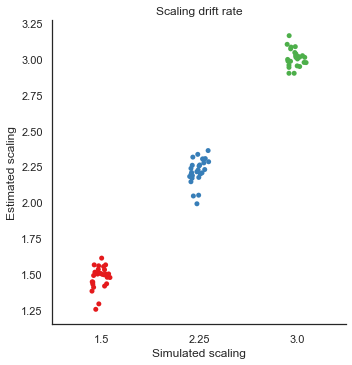
g = sns.catplot(x="t", y="e_t", data=param_recovery, palette="Set1")
g.set_axis_labels("Simulated NDT", "Estimated NDT")
plt.title("Non-decision time")
g.savefig("NDT_recovery.pdf")
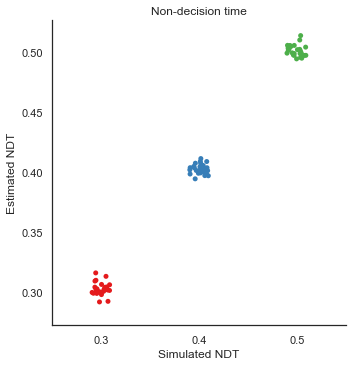
Fig. The correlation between simulated and estimated parameter values are high, which means recovery is good. There is somewhat worse recovery for the learning rate and scaling parameter, which makes sense given that they to a degree can explain the same variance (see below).
9. Separate learning rates for positive and negative prediction errors
Several studies have reported differences in updating of expected rewards following positive and negative prediction errors (e.g. to capture differences between D1 and D2 receptor function). To model asymmetric updating rates for positive and negative prediction errors you can set dual=True in the model. This will produce two estimated learning rates; alpha and pos_alpha, of which alpha then becomes the estimated learning rate for negative prediction errors.
# set dual=True to model separate learning rates for positive and negative prediction errors.
m_dual = hddm.HDDMrl(data, dual=True)
# set sample and burn-in
m_dual.sample(1500, burn=500, dbname="traces.db", db="pickle")
# print stats to get an overview of posterior distribution of estimated parameters
m_dual.print_stats()
[-----------------100%-----------------] 1500 of 1500 complete in 191.8 sec mean std 2.5q 25q 50q 75q 97.5q mc err
a 1.82633 0.0783844 1.67345 1.77512 1.82217 1.87568 1.9965 0.00295453
a_std 0.410321 0.0674141 0.306268 0.364889 0.401635 0.450473 0.564012 0.00270026
a_subj.3 2.17033 0.115262 1.95375 2.09614 2.16539 2.24181 2.4254 0.00548993
a_subj.4 1.89897 0.0579531 1.79347 1.85788 1.89605 1.9393 2.01907 0.00277538
a_subj.5 1.61113 0.082302 1.45691 1.55496 1.6061 1.66577 1.77686 0.00381988
a_subj.6 2.43691 0.101778 2.2429 2.36614 2.43347 2.50934 2.62957 0.00431407
a_subj.8 2.59792 0.144576 2.34397 2.499 2.59463 2.6892 2.92774 0.00726993
a_subj.12 2.06029 0.0799839 1.91855 2.00623 2.05359 2.11537 2.22798 0.00361356
a_subj.17 1.54875 0.100305 1.35735 1.4863 1.54396 1.61257 1.7653 0.0054701
a_subj.18 1.96151 0.122684 1.73789 1.87154 1.96274 2.04099 2.20959 0.00660454
a_subj.19 2.27976 0.108427 2.0839 2.20405 2.27507 2.34357 2.53175 0.00537144
a_subj.20 1.757 0.0906857 1.57908 1.70036 1.75772 1.81488 1.94106 0.00475469
a_subj.22 1.40039 0.0492764 1.3153 1.36434 1.39905 1.43278 1.50517 0.00258208
a_subj.23 1.95365 0.099402 1.77161 1.88705 1.9462 2.01884 2.15432 0.00426745
a_subj.24 1.68369 0.0978159 1.52375 1.61216 1.67733 1.74375 1.90374 0.0047914
a_subj.26 2.23402 0.0798351 2.08258 2.17478 2.23315 2.28916 2.38973 0.00366055
a_subj.33 1.57319 0.0707342 1.44946 1.52259 1.56998 1.62238 1.71148 0.00299887
a_subj.34 1.84701 0.0917249 1.67547 1.78566 1.84312 1.90886 2.02471 0.00440968
a_subj.35 1.85894 0.0913431 1.68528 1.79731 1.86485 1.92094 2.03658 0.00379595
a_subj.36 1.32917 0.0657278 1.20156 1.28636 1.32837 1.36863 1.46548 0.00299776
a_subj.39 1.58224 0.0571074 1.48113 1.54243 1.57864 1.61699 1.70573 0.00272969
a_subj.42 1.85728 0.0910291 1.68796 1.79839 1.85521 1.91323 2.04917 0.00501664
a_subj.50 1.57842 0.0593103 1.47311 1.53575 1.57541 1.61701 1.70146 0.00315943
a_subj.52 2.29593 0.104286 2.10454 2.22466 2.2942 2.35891 2.51119 0.00558897
a_subj.56 1.47579 0.0489699 1.38374 1.44303 1.47525 1.50802 1.57638 0.00203615
a_subj.59 1.41423 0.0838355 1.25798 1.3551 1.41686 1.47376 1.58004 0.00482176
a_subj.63 1.98606 0.105647 1.79733 1.91055 1.97667 2.05667 2.21026 0.00515372
a_subj.71 1.37492 0.0416381 1.29913 1.34635 1.37351 1.40374 1.45383 0.00193188
a_subj.75 1.04381 0.0424396 0.963908 1.01437 1.04343 1.07007 1.1287 0.00215329
a_subj.80 2.20728 0.0949151 2.0232 2.14268 2.20566 2.27035 2.40363 0.00343694
v 3.66306 0.432881 2.80263 3.36481 3.67691 3.94446 4.53137 0.0179453
v_std 2.16051 0.347665 1.59481 1.92183 2.11674 2.36274 2.98355 0.0183554
v_subj.3 4.05807 0.584568 3.05244 3.6736 4.01923 4.43582 5.33269 0.0211871
v_subj.4 0.93029 0.149903 0.668345 0.825182 0.921209 1.0267 1.25353 0.00749321
v_subj.5 3.10298 0.410738 2.35251 2.81169 3.11047 3.37633 3.94636 0.0155184
v_subj.6 4.37315 1.51163 2.02799 3.22323 4.26505 5.3469 7.84778 0.115543
v_subj.8 2.10131 0.291351 1.55417 1.89635 2.10656 2.2918 2.68403 0.0102131
v_subj.12 3.30997 0.27209 2.79541 3.12027 3.30714 3.51814 3.8123 0.00979875
v_subj.17 4.77054 0.654596 3.61074 4.32052 4.71783 5.15654 6.20269 0.0344306
v_subj.18 5.60507 0.914642 4.05708 4.95358 5.50239 6.14505 7.59222 0.0525223
v_subj.19 6.79667 0.531696 5.84821 6.41609 6.78247 7.15707 7.86691 0.0256374
v_subj.20 5.06997 0.751946 3.80191 4.51495 4.99583 5.54233 6.76405 0.0508111
v_subj.22 7.74229 0.554212 6.66899 7.38473 7.72739 8.10784 8.88024 0.0226088
v_subj.23 1.65386 0.326853 1.05624 1.43946 1.64962 1.84378 2.35648 0.0147053
v_subj.24 4.9282 0.716149 3.58835 4.46113 4.91188 5.38852 6.49608 0.0250187
v_subj.26 0.554038 0.159071 0.317581 0.447227 0.538658 0.634405 0.891184 0.00738979
v_subj.33 1.99289 1.5563 -0.0917214 0.979077 1.61419 2.62817 6.07535 0.0882033
v_subj.34 2.67755 0.743488 1.48379 2.19459 2.61205 3.01255 4.4251 0.0343761
v_subj.35 2.11529 0.418304 1.36401 1.83141 2.11525 2.37647 3.02335 0.0155763
v_subj.36 3.05497 1.16149 1.3637 2.20115 2.92209 3.67182 5.81363 0.0818964
v_subj.39 3.14393 1.01339 1.10825 2.48491 3.15981 3.77087 5.16142 0.0524964
v_subj.42 3.77651 0.368915 3.04478 3.53231 3.76981 4.00682 4.52743 0.0147786
v_subj.50 5.24503 0.428943 4.40896 4.98034 5.23241 5.51769 6.08356 0.0187869
v_subj.52 3.50906 0.403754 2.7295 3.22648 3.50778 3.78182 4.30659 0.0166646
v_subj.56 1.31785 0.983386 0.326642 0.749425 1.12579 1.50799 4.35855 0.0773137
v_subj.59 8.77448 1.21852 6.60213 7.93194 8.66269 9.53013 11.496 0.0836054
v_subj.63 2.23256 0.338367 1.62264 1.98565 2.22861 2.45895 2.91907 0.0129532
v_subj.71 3.79805 0.327746 3.15876 3.57293 3.79705 4.01523 4.43214 0.0119512
v_subj.75 4.97022 0.447116 4.13118 4.65435 4.96064 5.27331 5.81798 0.0167969
v_subj.80 2.12787 0.971202 0.846467 1.41587 1.88945 2.589 4.74006 0.0674847
t 0.428604 0.044101 0.353065 0.396248 0.425327 0.457601 0.525839 0.00218668
t_std 0.234719 0.0433914 0.164275 0.202987 0.229153 0.262883 0.333006 0.00233875
t_subj.3 1.06301 0.0242696 1.00809 1.04874 1.06433 1.08068 1.1041 0.00106904
t_subj.4 0.528016 0.0181393 0.489347 0.516371 0.529422 0.541093 0.560231 0.00082801
t_subj.5 0.521158 0.0134301 0.491967 0.512937 0.522271 0.530159 0.546061 0.000601849
t_subj.6 0.393535 0.031081 0.332742 0.371696 0.394455 0.414439 0.452232 0.00136618
t_subj.8 0.645487 0.046208 0.548299 0.616548 0.650334 0.677856 0.726427 0.00214894
t_subj.12 0.400791 0.0142303 0.371308 0.392207 0.401693 0.411239 0.427577 0.000644815
t_subj.17 0.49389 0.0160554 0.46639 0.484731 0.493694 0.501411 0.544435 0.000937253
t_subj.18 0.437714 0.024544 0.381513 0.423714 0.44101 0.455774 0.47827 0.00118883
t_subj.19 0.408016 0.0164337 0.370056 0.398919 0.408948 0.419889 0.434781 0.000790638
t_subj.20 0.514031 0.0132655 0.485829 0.505598 0.515052 0.522825 0.537302 0.000720981
t_subj.22 0.325148 0.00616492 0.311362 0.321639 0.32567 0.329167 0.33589 0.000321026
t_subj.23 0.48052 0.0231803 0.427495 0.466163 0.481808 0.497029 0.519889 0.000967584
t_subj.24 0.453918 0.0141035 0.424352 0.444748 0.454901 0.463995 0.478395 0.000737631
t_subj.26 0.443235 0.0347691 0.371609 0.418196 0.448561 0.469806 0.499016 0.00161531
t_subj.33 0.19289 0.0161553 0.163663 0.181761 0.191735 0.203197 0.227826 0.000650216
t_subj.34 0.341855 0.0304285 0.275627 0.325666 0.343243 0.358593 0.411272 0.00135037
t_subj.35 0.323872 0.0241005 0.275647 0.309315 0.323585 0.33817 0.371883 0.000954075
t_subj.36 0.448459 0.0124212 0.418934 0.441661 0.450627 0.457502 0.467191 0.000592505
t_subj.39 0.619463 0.0115061 0.593632 0.612822 0.620391 0.627636 0.639284 0.000519217
t_subj.42 0.38756 0.0160417 0.353556 0.377524 0.388542 0.398015 0.41576 0.000875023
t_subj.50 0.520546 0.0172755 0.482822 0.510046 0.524875 0.533784 0.54486 0.000986671
t_subj.52 0.507414 0.0233708 0.455127 0.493376 0.509698 0.523056 0.550123 0.00114481
t_subj.56 0.116896 0.011136 0.0907044 0.110031 0.117803 0.124486 0.136371 0.000481042
t_subj.59 0.367431 0.0187911 0.33152 0.355044 0.368221 0.377594 0.408335 0.0012207
t_subj.63 0.470553 0.0214161 0.423916 0.457205 0.471826 0.484268 0.508559 0.000923657
t_subj.71 0.156369 0.00617554 0.144548 0.152355 0.156495 0.16055 0.168231 0.000277601
t_subj.75 0.257439 0.00715949 0.240442 0.254217 0.25945 0.262397 0.266872 0.000398967
t_subj.80 0.0402711 0.0164579 0.0108391 0.0281409 0.0399061 0.05107 0.0745975 0.000551567
alpha -4.78158 0.898295 -6.75036 -5.29889 -4.70286 -4.15113 -3.26662 0.0521409
alpha_std 3.73289 1.06489 2.1336 2.99392 3.52618 4.33781 6.30655 0.0831372
alpha_subj.3 -7.05258 2.50159 -13.1917 -8.32234 -6.52649 -5.18567 -3.96031 0.124696
alpha_subj.4 0.426963 1.11459 -0.944668 -0.230608 0.250964 0.808489 2.92571 0.0541998
alpha_subj.5 -6.91208 2.70265 -14.1073 -8.38504 -6.20221 -4.93885 -3.59952 0.135496
alpha_subj.6 -7.8891 2.5143 -13.9728 -9.12846 -7.44981 -6.13023 -4.37058 0.130676
alpha_subj.8 -2.72998 0.994146 -4.36336 -2.88409 -2.58956 -2.32116 -1.87981 0.0494222
alpha_subj.12 -8.06559 2.69454 -14.9298 -9.48851 -7.54959 -6.1212 -4.43814 0.144476
alpha_subj.17 -6.60254 2.96442 -14.1679 -7.99399 -5.9254 -4.45374 -2.86398 0.158913
alpha_subj.18 -6.07482 2.68135 -13.1222 -7.13457 -5.22561 -4.18235 -3.13356 0.136542
alpha_subj.19 -3.92613 0.285418 -4.64184 -4.07693 -3.89082 -3.72418 -3.45543 0.0101292
alpha_subj.20 -3.50676 0.516536 -4.68548 -3.79117 -3.49135 -3.17623 -2.56029 0.0285649
alpha_subj.22 -9.2371 2.06096 -13.833 -10.3452 -8.81722 -7.74703 -6.32702 0.0931406
alpha_subj.23 -4.31396 2.64539 -11.1804 -5.27713 -3.51936 -2.54338 -1.35995 0.136443
alpha_subj.24 -1.55403 0.339719 -2.20419 -1.76759 -1.541 -1.34377 -0.857031 0.0101265
alpha_subj.26 2.3789 2.61685 -0.93534 1.21823 2.23266 3.52459 7.21916 0.174057
alpha_subj.33 -5.213 4.0036 -13.9326 -7.62198 -5.00017 -2.53649 1.71173 0.184676
alpha_subj.34 -5.53051 2.76871 -12.5893 -6.87964 -4.73883 -3.58031 -2.30041 0.141782
alpha_subj.35 -6.38576 3.13276 -14.0043 -7.9697 -5.83136 -4.1429 -2.09597 0.146654
alpha_subj.36 -1.79782 2.08031 -8.22385 -2.23937 -1.26025 -0.71467 0.467845 0.114779
alpha_subj.39 -5.44883 3.89269 -13.4074 -7.56688 -5.38491 -3.9298 2.91726 0.306435
alpha_subj.42 -5.04472 2.33085 -11.3301 -5.17445 -4.30883 -3.8231 -3.27149 0.132284
alpha_subj.50 -8.08276 2.46464 -14.181 -9.24783 -7.53744 -6.25954 -4.971 0.126942
alpha_subj.52 -3.82568 0.752882 -5.04399 -4.00424 -3.71483 -3.47445 -3.12819 0.0371159
alpha_subj.56 -5.44862 3.41322 -13.5386 -7.36032 -4.89808 -3.09328 -0.30246 0.18234
alpha_subj.59 -3.44337 0.488828 -4.45293 -3.66276 -3.39263 -3.14521 -2.72879 0.0247054
alpha_subj.63 -6.90635 2.82143 -13.3582 -8.47125 -6.38258 -4.78577 -3.09205 0.119088
alpha_subj.71 -8.45649 2.63845 -15.2664 -9.69164 -7.92428 -6.56692 -5.18337 0.138627
alpha_subj.75 -7.48641 2.73537 -14.0637 -8.70384 -6.88744 -5.49349 -3.90752 0.134957
alpha_subj.80 -5.58797 3.14239 -13.527 -7.20775 -4.67266 -3.26561 -1.78386 0.173523
pos_alpha -0.895935 0.339247 -1.54324 -1.11526 -0.909311 -0.674954 -0.160331 0.0180688
pos_alpha_std 1.45037 0.313221 0.953754 1.23314 1.42053 1.6352 2.12882 0.0199312
pos_alpha_subj.3 -0.739699 0.608631 -1.89483 -1.10114 -0.748097 -0.389608 0.549614 0.0252056
pos_alpha_subj.4 0.501533 0.880432 -0.924143 -0.107416 0.414538 1.00973 2.65335 0.0414756
pos_alpha_subj.5 0.343363 0.823 -0.927268 -0.207032 0.20958 0.824743 2.30273 0.0313956
pos_alpha_subj.6 -3.57442 0.488523 -4.37085 -3.91692 -3.64022 -3.26027 -2.50903 0.0374053
pos_alpha_subj.8 0.449901 0.783986 -0.861785 -0.0643286 0.390448 0.894634 2.34131 0.0299916
pos_alpha_subj.12 0.402094 0.39053 -0.288765 0.152244 0.383246 0.612424 1.26959 0.0123956
pos_alpha_subj.17 -1.03625 0.728279 -2.28107 -1.47547 -1.09125 -0.741944 0.869704 0.0404402
pos_alpha_subj.18 -1.95641 0.360458 -2.68864 -2.18083 -1.95473 -1.71167 -1.28532 0.016443
pos_alpha_subj.19 -1.67176 0.221585 -2.15427 -1.80486 -1.65991 -1.51665 -1.28461 0.00811834
pos_alpha_subj.20 -2.1366 0.329426 -2.81754 -2.35952 -2.11302 -1.90687 -1.52181 0.0211777
pos_alpha_subj.22 -1.52007 0.125742 -1.78746 -1.59736 -1.51762 -1.43222 -1.28096 0.00531203
pos_alpha_subj.23 0.0529679 1.00904 -1.98607 -0.507643 0.00876946 0.620401 2.14044 0.0414709
pos_alpha_subj.24 -1.34182 0.309116 -1.93674 -1.55106 -1.33801 -1.14381 -0.73865 0.0112161
pos_alpha_subj.26 0.0893943 0.970026 -1.58794 -0.484993 -0.01053 0.619843 2.44391 0.0521637
pos_alpha_subj.33 -2.24994 1.2274 -4.38351 -3.11987 -2.30015 -1.48697 0.414115 0.0705896
pos_alpha_subj.34 -0.704432 1.05906 -2.88173 -1.33173 -0.550406 0.0335074 1.12025 0.0505609
pos_alpha_subj.35 -0.739327 0.629917 -2.36813 -1.05908 -0.672616 -0.324667 0.371349 0.0253342
pos_alpha_subj.36 -1.56092 1.5089 -3.96919 -2.71246 -1.819 -0.56486 1.61682 0.107652
pos_alpha_subj.39 0.185904 1.77976 -4.36138 -0.191296 0.508164 1.23217 2.711 0.155413
pos_alpha_subj.42 -0.603407 0.253323 -1.11295 -0.760958 -0.598121 -0.435014 -0.103201 0.00879472
pos_alpha_subj.50 -1.37377 0.262776 -1.90291 -1.5452 -1.37773 -1.20679 -0.872482 0.00894318
pos_alpha_subj.52 0.0772404 0.36944 -0.635686 -0.178077 0.0697795 0.304712 0.851372 0.011965
pos_alpha_subj.56 -1.51497 1.97144 -5.41133 -2.83118 -1.37977 -0.24753 2.36421 0.128189
pos_alpha_subj.59 -2.10815 0.279822 -2.66591 -2.2839 -2.11047 -1.92215 -1.56226 0.0176411
pos_alpha_subj.63 1.29028 0.873231 -0.164205 0.68542 1.18272 1.8369 3.14479 0.0375058
pos_alpha_subj.71 -1.70335 0.21584 -2.1278 -1.83928 -1.70867 -1.56798 -1.24251 0.00688448
pos_alpha_subj.75 -0.502723 0.297922 -1.07137 -0.704546 -0.508679 -0.304064 0.0950879 0.0107456
pos_alpha_subj.80 -1.61934 1.26102 -3.49573 -2.52006 -1.82877 -0.950009 1.36519 0.0865199
DIC: 9186.303547
deviance: 9083.079636
pD: 103.223911
m_dual.plot_posteriors()
Plotting a
Plotting a_std
Plotting v
Plotting v_std
Plotting t
Plotting t_std
Plotting alpha
Plotting alpha_std
Plotting pos_alpha
Plotting pos_alpha_std

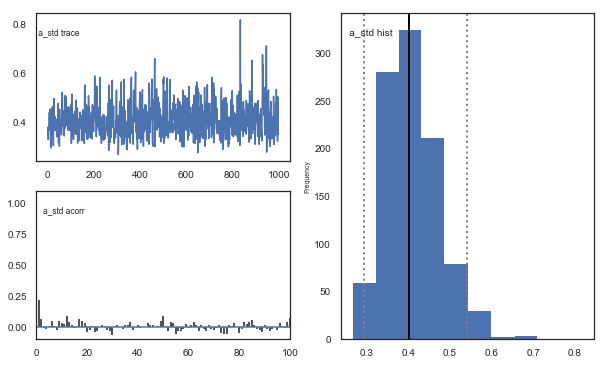
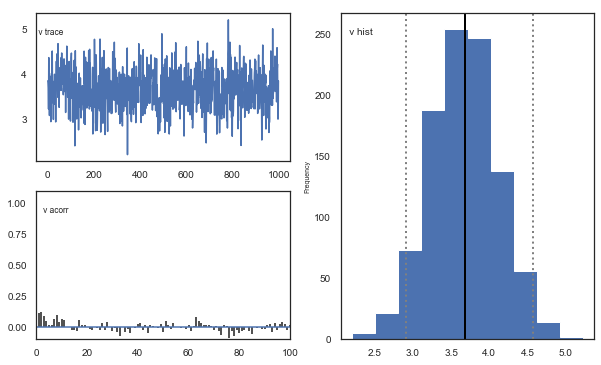
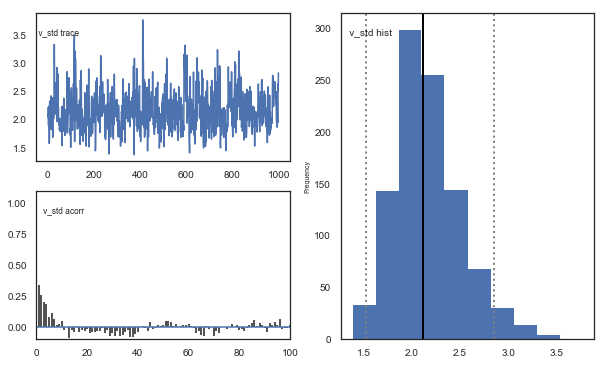

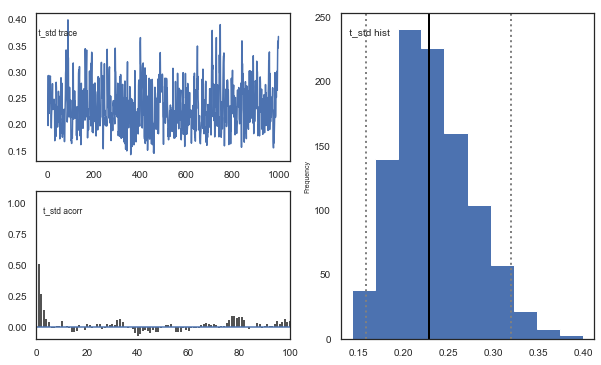
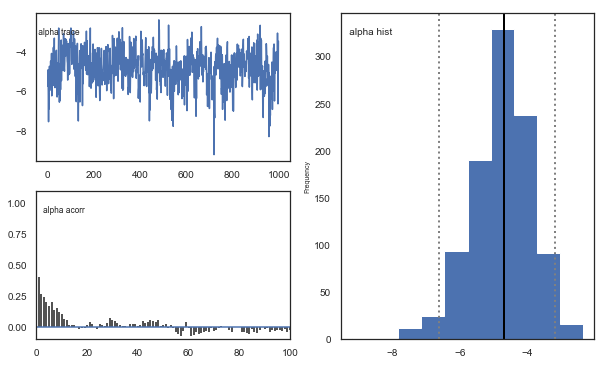
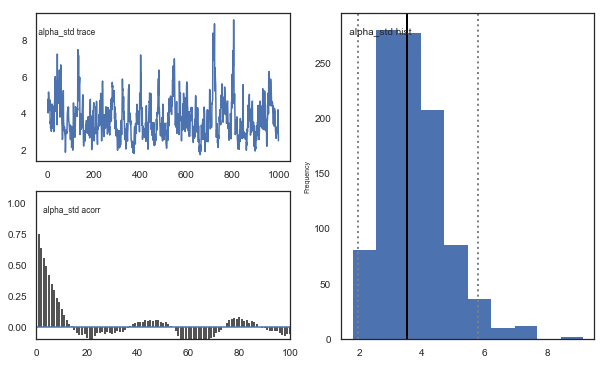
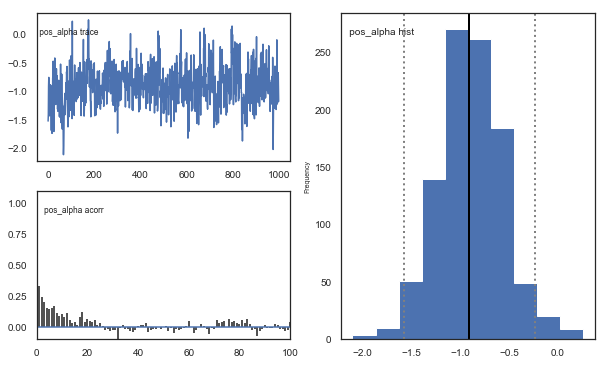
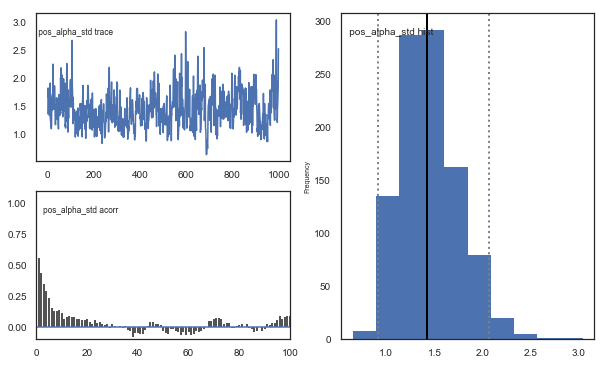
Fig. There’s more autocorrelation in this model compared to the one with a single learning rate. First, let’s test whether it converges.
# estimate convergence
models = []
for i in range(3):
m = hddm.HDDMrl(data=data, dual=True)
m.sample(1500, burn=500, dbname="traces.db", db="pickle")
models.append(m)
# get max gelman-statistic value. shouldn't be higher than 1.1
np.max(list(gelman_rubin(models).values()))
[-----------------100%-----------------] 1501 of 1500 complete in 190.3 sec
/Users/madslundpedersen/anaconda/envs/py36/lib/python3.6/site-packages/kabuki/analyze.py:148: FutureWarning:
.ix is deprecated. Please use
.loc for label based indexing or
.iloc for positional indexing
See the documentation here:
http://pandas.pydata.org/pandas-docs/stable/user_guide/indexing.html#ix-indexer-is-deprecated
samples[i,:] = model.nodes_db.ix[name, 'node'].trace()
/Users/madslundpedersen/anaconda/envs/py36/lib/python3.6/site-packages/pandas/core/indexing.py:961: FutureWarning:
.ix is deprecated. Please use
.loc for label based indexing or
.iloc for positional indexing
See the documentation here:
http://pandas.pydata.org/pandas-docs/stable/user_guide/indexing.html#ix-indexer-is-deprecated
return getattr(section, self.name)[new_key]
1.014473317822456
gelman_rubin(models)
{'a': 1.000125615977507,
'a_std': 1.000293824141093,
'a_subj.3': 0.9995587497036598,
'a_subj.4': 0.9995663288755461,
'a_subj.5': 1.002412638832063,
'a_subj.6': 0.9997479711112068,
'a_subj.8': 1.0010518773251582,
'a_subj.12': 0.9997234039050327,
'a_subj.17': 1.0004801627764193,
'a_subj.18': 1.0001624055351832,
'a_subj.19': 0.9996592350878782,
'a_subj.20': 1.0029800834579676,
'a_subj.22': 1.0012450357713991,
'a_subj.23': 0.9996812901217333,
'a_subj.24': 1.0017171481263634,
'a_subj.26': 0.9997923090627893,
'a_subj.33': 1.0023439140007413,
'a_subj.34': 0.9998184112544697,
'a_subj.35': 0.9998414872289898,
'a_subj.36': 0.9999848867852217,
'a_subj.39': 0.9996300864110935,
'a_subj.42': 1.0011762287987338,
'a_subj.50': 0.999964638152394,
'a_subj.52': 1.0006531924956916,
'a_subj.56': 1.0002379308081606,
'a_subj.59': 1.0036030711499442,
'a_subj.63': 1.0037500688653909,
'a_subj.71': 1.000132861501354,
'a_subj.75': 0.9997763551013711,
'a_subj.80': 0.9996110136879114,
'v': 1.0001729942650572,
'v_std': 1.0007050210999138,
'v_subj.3': 1.00089570652398,
'v_subj.4': 1.0024232190875875,
'v_subj.5': 1.000031484184937,
'v_subj.6': 1.000246348222359,
'v_subj.8': 0.9998188908969313,
'v_subj.12': 1.0002972651898785,
'v_subj.17': 1.0053152485244228,
'v_subj.18': 1.0035678009993956,
'v_subj.19': 1.0007676729224628,
'v_subj.20': 1.0138533173993516,
'v_subj.22': 1.0001920445137138,
'v_subj.23': 1.0001643719289113,
'v_subj.24': 1.0003166942511994,
'v_subj.26': 1.012037804264053,
'v_subj.33': 1.008822207930599,
'v_subj.34': 1.001232834456808,
'v_subj.35': 1.0025938840649362,
'v_subj.36': 1.000069726432657,
'v_subj.39': 0.9998994943313908,
'v_subj.42': 0.9996973440151383,
'v_subj.50': 1.001143117423489,
'v_subj.52': 1.0002753174216377,
'v_subj.56': 0.9999573151498712,
'v_subj.59': 1.0104883818941242,
'v_subj.63': 1.00189569663142,
'v_subj.71': 0.9995411611089315,
'v_subj.75': 0.9995588725849562,
'v_subj.80': 1.0136685141891846,
't': 1.0004114901695569,
't_std': 1.0007933788432173,
't_subj.3': 0.9996171871762616,
't_subj.4': 1.0001300490519083,
't_subj.5': 1.0028746028937425,
't_subj.6': 0.9997742835195009,
't_subj.8': 1.001323887846369,
't_subj.12': 0.9996809520992331,
't_subj.17': 1.004979239177261,
't_subj.18': 1.001443056131703,
't_subj.19': 1.001276450267826,
't_subj.20': 1.0017222614492018,
't_subj.22': 1.0014446464850104,
't_subj.23': 1.0001854182394025,
't_subj.24': 1.0021360259836916,
't_subj.26': 0.9998130722506594,
't_subj.33': 1.0041403512850227,
't_subj.34': 1.000662368674309,
't_subj.35': 0.9997816559126319,
't_subj.36': 1.000389429370145,
't_subj.39': 1.0004989245164477,
't_subj.42': 1.003660719681535,
't_subj.50': 0.9996523807207587,
't_subj.52': 1.0001385838960493,
't_subj.56': 1.000436582928671,
't_subj.59': 1.0097109617328988,
't_subj.63': 1.0023205899326733,
't_subj.71': 1.0008294977192809,
't_subj.75': 0.9996035166755558,
't_subj.80': 0.9999656516467259,
'alpha': 1.0008526268630051,
'alpha_std': 1.0053219932778943,
'alpha_subj.3': 0.999501514240184,
'alpha_subj.4': 1.0073664853377151,
'alpha_subj.5': 1.0002667649822319,
'alpha_subj.6': 1.0010858103024662,
'alpha_subj.8': 1.0020288089122238,
'alpha_subj.12': 0.9999329084180971,
'alpha_subj.17': 1.002245596723081,
'alpha_subj.18': 1.001122573161122,
'alpha_subj.19': 0.9995903836225754,
'alpha_subj.20': 1.0073888183284407,
'alpha_subj.22': 1.0069862383738115,
'alpha_subj.23': 1.001612686745671,
'alpha_subj.24': 0.9999712749048636,
'alpha_subj.26': 1.01440875592447,
'alpha_subj.33': 1.00670721072335,
'alpha_subj.34': 0.9995131597377838,
'alpha_subj.35': 1.001250997993986,
'alpha_subj.36': 1.002683758400843,
'alpha_subj.39': 1.004739288526853,
'alpha_subj.42': 1.0008115954315624,
'alpha_subj.50': 1.0010984441307196,
'alpha_subj.52': 1.0025159489951863,
'alpha_subj.56': 1.00067808806373,
'alpha_subj.59': 1.0002771782983166,
'alpha_subj.63': 1.0011017204118449,
'alpha_subj.71': 1.0006215161259082,
'alpha_subj.75': 1.0026779077970407,
'alpha_subj.80': 1.0002319983391794,
'pos_alpha': 1.00257297410585,
'pos_alpha_std': 1.001617498309611,
'pos_alpha_subj.3': 0.9995865019882652,
'pos_alpha_subj.4': 1.0062437837747629,
'pos_alpha_subj.5': 1.0034825487152508,
'pos_alpha_subj.6': 1.0005618815584847,
'pos_alpha_subj.8': 1.0001291334737075,
'pos_alpha_subj.12': 1.0001556376957397,
'pos_alpha_subj.17': 1.0001016511811331,
'pos_alpha_subj.18': 1.0024023231634642,
'pos_alpha_subj.19': 1.000007119184469,
'pos_alpha_subj.20': 1.0119860515816212,
'pos_alpha_subj.22': 0.9998692465833887,
'pos_alpha_subj.23': 1.0005347917836798,
'pos_alpha_subj.24': 1.000873682844545,
'pos_alpha_subj.26': 1.014473317822456,
'pos_alpha_subj.33': 1.0057921277935418,
'pos_alpha_subj.34': 1.0011151145301689,
'pos_alpha_subj.35': 1.0016919400556858,
'pos_alpha_subj.36': 1.0003570992127564,
'pos_alpha_subj.39': 1.0056374569990023,
'pos_alpha_subj.42': 0.999898151417554,
'pos_alpha_subj.50': 1.000865449897151,
'pos_alpha_subj.52': 1.0000890958138444,
'pos_alpha_subj.56': 0.9999626321602774,
'pos_alpha_subj.59': 1.0053232725751076,
'pos_alpha_subj.63': 1.0005550289110994,
'pos_alpha_subj.71': 0.9996504478249013,
'pos_alpha_subj.75': 0.999846688983168,
'pos_alpha_subj.80': 1.0140403525074555}
Convergence looks good, i.e. no parameters with gelman-rubin statistic > 1.1.
# Create a new model that has all traces concatenated
# of individual models.
m_dual = kabuki.utils.concat_models(models)
And then we can have a look at the joint posterior distribution:
alpha, t, a, v, pos_alpha = m_dual.nodes_db.node[["alpha", "t", "a", "v", "pos_alpha"]]
samples = {
"alpha": alpha.trace(),
"pos_alpha": pos_alpha.trace(),
"t": t.trace(),
"a": a.trace(),
"v": v.trace(),
}
samp = pd.DataFrame(data=samples)
def corrfunc(x, y, **kws):
r, _ = stats.pearsonr(x, y)
ax = plt.gca()
ax.annotate("r = {:.2f}".format(r), xy=(0.1, 0.9), xycoords=ax.transAxes)
g = sns.PairGrid(samp, palette=["red"])
g.map_upper(plt.scatter, s=10)
g.map_diag(sns.distplot, kde=False)
g.map_lower(sns.kdeplot, cmap="Blues_d")
g.map_lower(corrfunc)
g.savefig("matrix_plot.png")
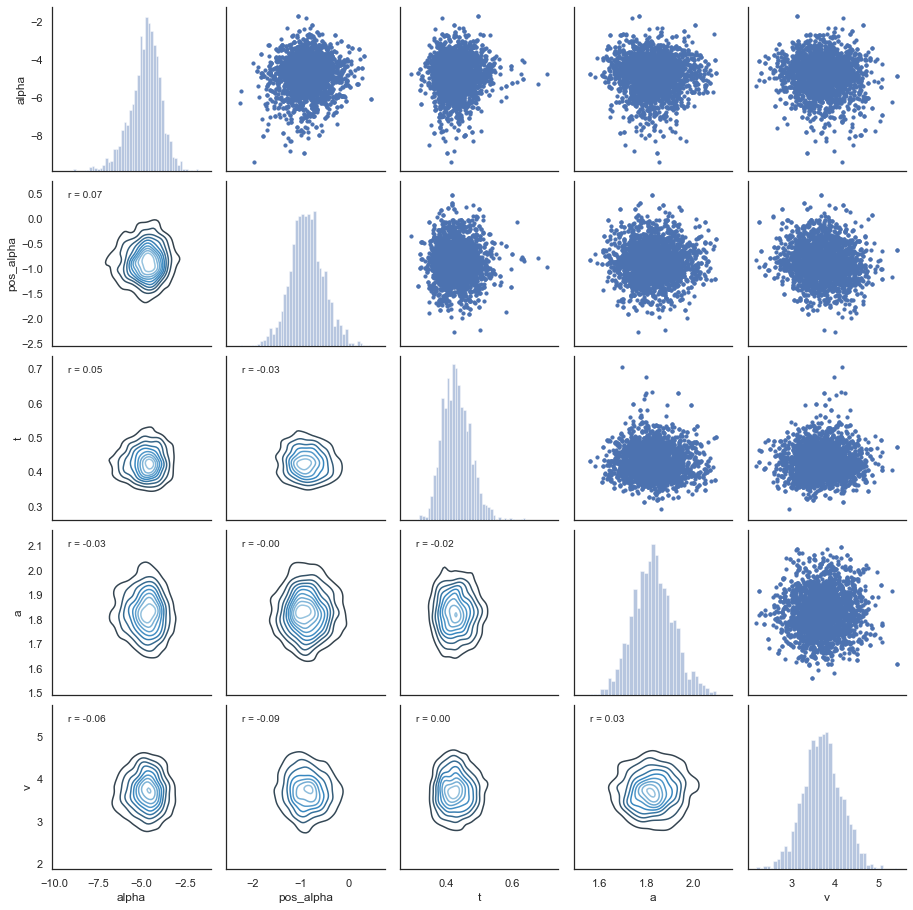
Fig. The correlation between parameters is generally low.
Posterior predictive check
The DIC for this dual learning rate model is better than for the single learning rate model. We can therefore check whether we can detect this improvement in the ability to recreate choice and RT patterns:
# create empty dataframe to store simulated data
sim_data = pd.DataFrame()
# create a column samp to be used to identify the simulated data sets
data["samp"] = 0
# get traces, note here we extract traces from m_dual
traces = m_dual.get_traces()
# decide how many times to repeat simulation process. repeating this multiple times is generally recommended as it better captures the uncertainty in the posterior distribution, but will also take some time
for i in tqdm(range(1, 51)):
# randomly select a row in the traces to use for extracting parameter values
sample = np.random.randint(0, traces.shape[0] - 1)
# loop through all subjects in observed data
for s in data.subj_idx.unique():
# get number of trials for each condition.
size0 = len(
data[(data["subj_idx"] == s) & (data["split_by"] == 0)].trial.unique()
)
size1 = len(
data[(data["subj_idx"] == s) & (data["split_by"] == 1)].trial.unique()
)
size2 = len(
data[(data["subj_idx"] == s) & (data["split_by"] == 2)].trial.unique()
)
# set parameter values for simulation
a = traces.loc[sample, "a_subj." + str(s)]
t = traces.loc[sample, "t_subj." + str(s)]
scaler = traces.loc[sample, "v_subj." + str(s)]
# when generating data with two learning rates pos_alpha represents learning rate for positive prediction errors and alpha for negative prediction errors
alphaInv = traces.loc[sample, "alpha_subj." + str(s)]
pos_alphaInv = traces.loc[sample, "pos_alpha_subj." + str(s)]
# take inverse logit of estimated alpha and pos_alpha
alpha = np.exp(alphaInv) / (1 + np.exp(alphaInv))
pos_alpha = np.exp(pos_alphaInv) / (1 + np.exp(pos_alphaInv))
# simulate data for each condition changing only values of size, p_upper, p_lower and split_by between conditions.
sim_data0 = hddm.generate.gen_rand_rlddm_data(
a=a,
t=t,
scaler=scaler,
alpha=alpha,
pos_alpha=pos_alpha,
size=size0,
p_upper=0.8,
p_lower=0.2,
split_by=0,
)
sim_data1 = hddm.generate.gen_rand_rlddm_data(
a=a,
t=t,
scaler=scaler,
alpha=alpha,
pos_alpha=pos_alpha,
size=size1,
p_upper=0.7,
p_lower=0.3,
split_by=1,
)
sim_data2 = hddm.generate.gen_rand_rlddm_data(
a=a,
t=t,
scaler=scaler,
alpha=alpha,
pos_alpha=pos_alpha,
size=size2,
p_upper=0.6,
p_lower=0.4,
split_by=2,
)
# append the conditions
sim_data0 = sim_data0.append([sim_data1, sim_data2], ignore_index=True)
# assign subj_idx
sim_data0["subj_idx"] = s
# identify that these are simulated data
sim_data0["type"] = "simulated"
# identify the simulated data
sim_data0["samp"] = i
# append data from each subject
sim_data = sim_data.append(sim_data0, ignore_index=True)
# combine observed and simulated data
ppc_dual_data = data[
["subj_idx", "response", "split_by", "rt", "trial", "feedback", "samp"]
].copy()
ppc_dual_data["type"] = "observed"
ppc_dual_sdata = sim_data[
["subj_idx", "response", "split_by", "rt", "trial", "feedback", "type", "samp"]
].copy()
ppc_dual_data = ppc_dual_data.append(ppc_dual_sdata)
100%|██████████| 50/50 [31:12<00:00, 37.44s/it]
/Users/madslundpedersen/anaconda/envs/py36/lib/python3.6/site-packages/pandas/core/frame.py:7138: FutureWarning: Sorting because non-concatenation axis is not aligned. A future version
of pandas will change to not sort by default.
To accept the future behavior, pass 'sort=False'.
To retain the current behavior and silence the warning, pass 'sort=True'.
sort=sort,
# for practical reasons we only look at the first 40 trials for each subject in a given condition
plot_ppc_dual_data = ppc_dual_data[ppc_dual_data.trial < 41].copy()
Choice
# bin trials to for smoother estimate of response proportion across learning
plot_ppc_dual_data["bin_trial"] = pd.cut(
plot_ppc_dual_data.trial, 11, labels=np.linspace(0, 10, 11)
).astype("int64")
# calculate means for each sample
sums = (
plot_ppc_dual_data.groupby(["bin_trial", "split_by", "samp", "type"])
.mean()
.reset_index()
)
# calculate the overall mean response across samples
ppc_dual_sim = sums.groupby(["bin_trial", "split_by", "type"]).mean().reset_index()
# initiate columns that will have the upper and lower bound of the hpd
ppc_dual_sim["upper_hpd"] = 0
ppc_dual_sim["lower_hpd"] = 0
for i in range(0, ppc_dual_sim.shape[0]):
# calculate the hpd/hdi of the predicted mean responses across bin_trials
hdi = pymc.utils.hpd(
sums.response[
(sums["bin_trial"] == ppc_dual_sim.bin_trial[i])
& (sums["split_by"] == ppc_dual_sim.split_by[i])
& (sums["type"] == ppc_dual_sim.type[i])
],
alpha=0.1,
)
ppc_dual_sim.loc[i, "upper_hpd"] = hdi[1]
ppc_dual_sim.loc[i, "lower_hpd"] = hdi[0]
# calculate error term as the distance from upper bound to mean
ppc_dual_sim["up_err"] = ppc_dual_sim["upper_hpd"] - ppc_dual_sim["response"]
ppc_dual_sim["low_err"] = ppc_dual_sim["response"] - ppc_dual_sim["lower_hpd"]
ppc_dual_sim["model"] = "RLDDM_dual_learning"
# plotting evolution of choice proportion for best option across learning for observed and simulated data.
fig, axs = plt.subplots(figsize=(15, 5), nrows=1, ncols=3, sharex=True, sharey=True)
for i in range(0, 3):
ax = axs[i]
d = ppc_dual_sim[(ppc_dual_sim.split_by == i) & (ppc_dual_sim.type == "simulated")]
ax.errorbar(
d.bin_trial,
d.response,
yerr=[d.low_err, d.up_err],
label="simulated",
color="orange",
)
d = ppc_sim[(ppc_dual_sim.split_by == i) & (ppc_dual_sim.type == "observed")]
ax.plot(d.bin_trial, d.response, linewidth=3, label="observed")
ax.set_title("split_by = %i" % i, fontsize=20)
ax.set_ylabel("mean response")
ax.set_xlabel("trial")
plt.legend()
<matplotlib.legend.Legend at 0x128f93208>
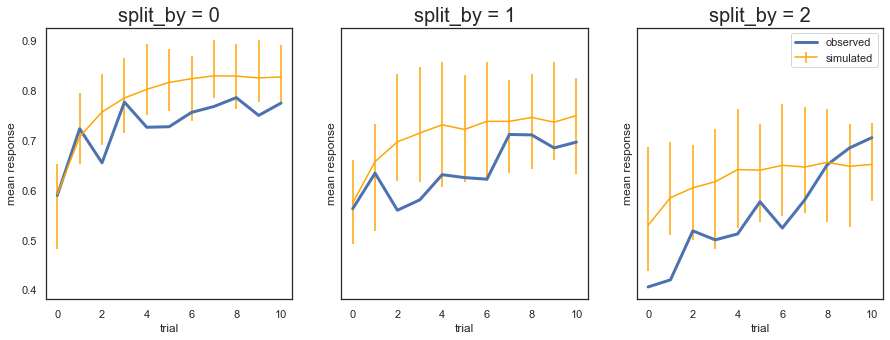
Fig. The plots display the rate of choosing the best option (response = 1) across learning and condition. The model generates data (orange) that closely follows the observed behavior (blue), with the exception of performance early in the most difficult condition (split_by=2).
PPC for single vs. dual learning rate
To get a better sense of differences in ability to predict data between the single and dual learning rate model we can plot them together:
# plotting evolution of choice proportion for best option across learning for observed and simulated data. Compared for model with single and dual learning rate.
fig, axs = plt.subplots(figsize=(15, 5), nrows=1, ncols=3, sharex=True, sharey=True)
for i in range(0, 3):
ax = axs[i]
d_single = ppc_sim[(ppc_sim.split_by == i) & (ppc_sim.type == "simulated")]
# slightly move bin_trial to avoid overlap in errorbars
d_single["bin_trial"] += 0.2
ax.errorbar(
d_single.bin_trial,
d_single.response,
yerr=[d_single.low_err, d_single.up_err],
label="simulated_single",
color="orange",
)
d_dual = ppc_dual_sim[
(ppc_dual_sim.split_by == i) & (ppc_dual_sim.type == "simulated")
]
ax.errorbar(
d_dual.bin_trial,
d_dual.response,
yerr=[d_dual.low_err, d_dual.up_err],
label="simulated_dual",
color="green",
)
d = ppc_sim[(ppc_dual_sim.split_by == i) & (ppc_dual_sim.type == "observed")]
ax.plot(d.bin_trial, d.response, linewidth=3, label="observed")
ax.set_title("split_by = %i" % i, fontsize=20)
ax.set_ylabel("mean response")
ax.set_xlabel("trial")
plt.xlim(-0.5, 10.5)
plt.legend()
/Users/madslundpedersen/anaconda/envs/py36/lib/python3.6/site-packages/ipykernel/__main__.py:7: SettingWithCopyWarning:
A value is trying to be set on a copy of a slice from a DataFrame.
Try using .loc[row_indexer,col_indexer] = value instead
See the caveats in the documentation: http://pandas.pydata.org/pandas-docs/stable/user_guide/indexing.html#returning-a-view-versus-a-copy
<matplotlib.legend.Legend at 0x128b7f5f8>
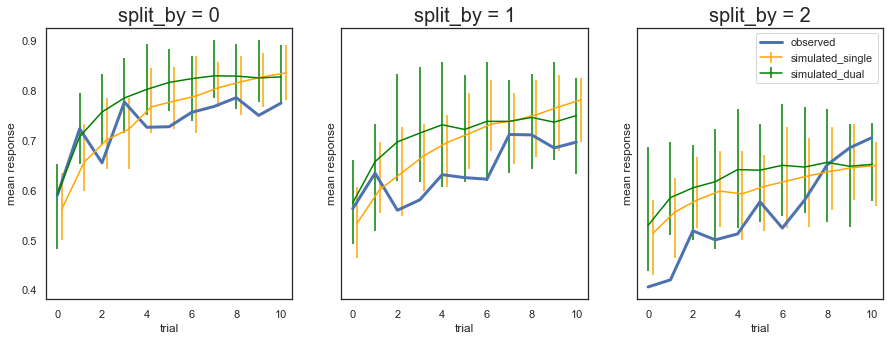
Fig. The predictions from the model with two learning rates are not very different from the model with single learning rate, and a similar overprediction of performance early on for the most difficult condition (split_by =2).
RT
plot_ppc_data["type_compare"] = np.where(
plot_ppc_data["type"] == "observed",
plot_ppc_data["type"],
"simulated_single_learning",
)
plot_ppc_dual_data["type_compare"] = np.where(
plot_ppc_dual_data["type"] == "observed",
plot_ppc_dual_data["type"],
"simulated_dual_learning",
)
dual_vs_single_pcc = plot_ppc_data.append(plot_ppc_dual_data)
dual_vs_single_pcc["reaction time"] = np.where(
dual_vs_single_pcc["response"] == 1,
dual_vs_single_pcc.rt,
0 - dual_vs_single_pcc.rt,
)
# plotting evolution of choice proportion for best option across learning for observed and simulated data. We use bins of trials because plotting individual trials would be very noisy.
g = sns.FacetGrid(dual_vs_single_pcc, col="split_by", hue="type_compare", height=5)
g.map(sns.kdeplot, "reaction time", bw=0.01).set_ylabels("Density")
g.add_legend()
<seaborn.axisgrid.FacetGrid at 0x12d4b3e10>

Fig. Again there’s not a big difference between the two models. Both models slightly overpredict performance for the medium (split_by =1) and hard (split_by = 2) conditions, as identified by lower densities for the negative (worst option choices) in the simulated compared to observed data.
Transform alpha and pos_alpha
To interpret the parameter estimates for alpha and pos_alpha you have to transform them with the inverse logit where learning rate for negative prediction error is alpha and learning rate for positive prediction errors is pos_alpha. For this dataset the learning rate is estimated to be higher for positive than negative prediction errors.
# plot alpha for positive and negative learning rate
traces = m_dual.get_traces()
neg_alpha = np.exp(traces["alpha"]) / (1 + np.exp(traces["alpha"]))
pos_alpha = np.exp(traces["pos_alpha"]) / (1 + np.exp(traces["pos_alpha"]))
sns.kdeplot(
neg_alpha, color="r", label="neg_alpha: " + str(np.round(np.mean(neg_alpha), 3))
)
sns.kdeplot(
pos_alpha, color="b", label="pos_alpha: " + str(np.round(np.mean(pos_alpha), 3))
)
<matplotlib.axes._subplots.AxesSubplot at 0x128fe3358>
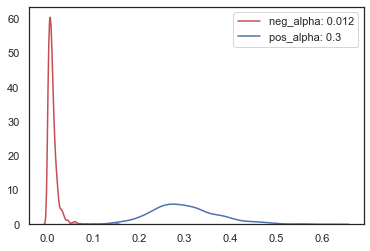
Fig. The positive learning rate is estimated to be stronger than the negative learning rate. Sticky choice, tendencies to repeat choices, could be driving some of this difference. The current model does not allow to test for this, however, but it could be tested in the future if we implement a regression version of RLDDM (similar to HDDMRegressor).
Simulate data with learning rates for positive and negative prediction errors
Here’s how you would simulate data with a learning rate for positive and negative predictions of 0.2 and 0.4, respectively:
hddm.generate.gen_rand_rlddm_data(
a=1, t=0.3, alpha=0.2, pos_alpha=0.4, scaler=2, p_upper=0.8, p_lower=0.2, size=10
)
| q_up | q_low | sim_drift | response | rt | feedback | subj_idx | split_by | trial | |
|---|---|---|---|---|---|---|---|---|---|
| 0 | 0.50000 | 0.5000 | 0.00000 | 1.0 | 0.583 | 1.0 | 0 | 0 | 1 |
| 1 | 0.70000 | 0.5000 | 0.40000 | 0.0 | 0.479 | 0.0 | 0 | 0 | 2 |
| 2 | 0.70000 | 0.4000 | 0.60000 | 1.0 | 0.450 | 1.0 | 0 | 0 | 3 |
| 3 | 0.82000 | 0.4000 | 0.84000 | 1.0 | 0.403 | 1.0 | 0 | 0 | 4 |
| 4 | 0.89200 | 0.4000 | 0.98400 | 0.0 | 0.732 | 0.0 | 0 | 0 | 5 |
| 5 | 0.89200 | 0.3200 | 1.14400 | 0.0 | 0.396 | 0.0 | 0 | 0 | 6 |
| 6 | 0.89200 | 0.2560 | 1.27200 | 1.0 | 0.964 | 0.0 | 0 | 0 | 7 |
| 7 | 0.71360 | 0.2560 | 0.91520 | 1.0 | 0.493 | 1.0 | 0 | 0 | 8 |
| 8 | 0.82816 | 0.2560 | 1.14432 | 0.0 | 0.360 | 0.0 | 0 | 0 | 9 |
| 9 | 0.82816 | 0.2048 | 1.24672 | 1.0 | 0.483 | 1.0 | 0 | 0 | 10 |
10. depends_on vs. split_by
HDDMrl can be used to estimate separate parameters just as in the standard HDDM. But in RL you typically estimate the same learning rates and inverse temperature across conditions. That’s one reason why you have to specify condition in the split_by-column instead of depends_on. (The other is that if you use depends_on the expected rewards will not get updated properly). But depends_on is still useful, for example if you want to estimate the effect of group on parameters. As an example we can simulate a dataset with two groups that have different decision thresholds:
data1 = hddm.generate.gen_rand_rlddm_data(
a=1, t=0.3, alpha=0.4, scaler=2, p_upper=0.8, p_lower=0.2, subjs=50, size=50
)
data1["group"] = "group1"
data2 = hddm.generate.gen_rand_rlddm_data(
a=2, t=0.3, alpha=0.4, scaler=2, p_upper=0.8, p_lower=0.2, subjs=50, size=50
)
data2["group"] = "group2"
group_data = data1.append(data2)
group_data["q_init"] = 0.5
m = hddm.HDDMrl(
group_data, depends_on={"v": "group", "a": "group", "t": "group", "alpha": "group"}
)
m.sample(1500, burn=500, dbname="traces.db", db="pickle")
[-----------------100%-----------------] 1500 of 1500 complete in 380.4 sec
<pymc.MCMC.MCMC at 0x129c3eef0>
# the plot shows that the model was able to recover the different decision threshold across groups.
a_group1, a_group2 = m.nodes_db.node[["a(group1)", "a(group2)"]]
hddm.analyze.plot_posterior_nodes([a_group1, a_group2])
plt.xlabel("decision threshold")
plt.ylabel("Posterior probability")
plt.xlim(0.7, 2.3)
plt.title("Posterior of decision threshold group means")
Text(0.5, 1.0, 'Posterior of decision threshold group means')
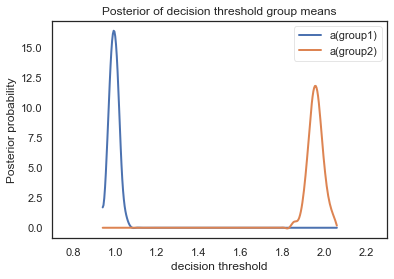
11. Probabilistic binary outcomes vs. normally distributed outcomes
The examples so far have all been using a task structure where the outcomes are binary and probabilistic. But the model can also be applied to other types of outcomes. Here we show how you can generate and model data with normally distributed outcomes. As you will see you don’t have to do any modifications to the model estimation process, but you have to change the input for generating data. Also note that the scaling parameter (v) will scale negatively with the values of the observed outcomes because the combined drift rate needs to be plausible.
# This is how we generated data so far, defining the probability of reward (1) for actions/stimuli associated with upper and lower boundary.
# binary probabilistic outcomes
hddm.generate.gen_rand_rlddm_data(
a=2, t=0.3, scaler=2, alpha=0.2, size=10, p_upper=0.2, p_lower=0.8
)
| q_up | q_low | sim_drift | response | rt | feedback | subj_idx | split_by | trial | |
|---|---|---|---|---|---|---|---|---|---|
| 0 | 0.50 | 0.500000 | 0.000000 | 0.0 | 1.175 | 1.0 | 0 | 0 | 1 |
| 1 | 0.50 | 0.600000 | -0.200000 | 0.0 | 1.056 | 1.0 | 0 | 0 | 2 |
| 2 | 0.50 | 0.680000 | -0.360000 | 0.0 | 0.977 | 1.0 | 0 | 0 | 3 |
| 3 | 0.50 | 0.744000 | -0.488000 | 1.0 | 0.918 | 1.0 | 0 | 0 | 4 |
| 4 | 0.60 | 0.744000 | -0.288000 | 0.0 | 1.109 | 1.0 | 0 | 0 | 5 |
| 5 | 0.60 | 0.795200 | -0.390400 | 0.0 | 1.761 | 1.0 | 0 | 0 | 6 |
| 6 | 0.60 | 0.836160 | -0.472320 | 0.0 | 1.634 | 1.0 | 0 | 0 | 7 |
| 7 | 0.60 | 0.868928 | -0.537856 | 0.0 | 3.159 | 1.0 | 0 | 0 | 8 |
| 8 | 0.60 | 0.895142 | -0.590285 | 1.0 | 1.070 | 0.0 | 0 | 0 | 9 |
| 9 | 0.48 | 0.895142 | -0.830285 | 0.0 | 1.455 | 1.0 | 0 | 0 | 10 |
# If instead the outcomes are drawn from a normal distribution you will have to set binary_outcome to False and instead of p_upper and p_upper define the mean (mu) and sd
# of the normal distribution for both alternatives. Note that we change the initial q-value to 0, and that we reduce the scaling factor.
# normally distributed outcomes
hddm.generate.gen_rand_rlddm_data(
a=2,
t=0.3,
scaler=0.2,
alpha=0.2,
size=10,
mu_upper=8,
mu_lower=2,
sd_upper=1,
sd_lower=1,
binary_outcome=False,
q_init=0,
)
| q_up | q_low | sim_drift | response | rt | feedback | subj_idx | split_by | trial | |
|---|---|---|---|---|---|---|---|---|---|
| 0 | 0.000000 | 0.000000 | 0.000000 | 0.0 | 1.234 | 2.756728 | 0 | 0 | 1 |
| 1 | 0.000000 | 0.551346 | -0.110269 | 0.0 | 2.057 | 1.489547 | 0 | 0 | 2 |
| 2 | 0.000000 | 0.738986 | -0.147797 | 0.0 | 1.530 | 3.807553 | 0 | 0 | 3 |
| 3 | 0.000000 | 1.352699 | -0.270540 | 0.0 | 2.645 | 1.417042 | 0 | 0 | 4 |
| 4 | 0.000000 | 1.365568 | -0.273114 | 0.0 | 3.384 | 3.729184 | 0 | 0 | 5 |
| 5 | 0.000000 | 1.838291 | -0.367658 | 1.0 | 1.082 | 8.566567 | 0 | 0 | 6 |
| 6 | 1.713313 | 1.838291 | -0.024996 | 0.0 | 0.975 | -0.502434 | 0 | 0 | 7 |
| 7 | 1.713313 | 1.370146 | 0.068633 | 0.0 | 1.712 | 0.961576 | 0 | 0 | 8 |
| 8 | 1.713313 | 1.288432 | 0.084976 | 0.0 | 0.578 | 1.455894 | 0 | 0 | 9 |
| 9 | 1.713313 | 1.321924 | 0.078278 | 1.0 | 0.489 | 7.676751 | 0 | 0 | 10 |
# We can generate a dataset where 30 subjects perform 50 trials each. Note that we set the scaler to be lower than for the binary outcomes as otherwise
# the resulting drift will be unrealistically high.
norm_data = hddm.generate.gen_rand_rlddm_data(
a=2,
t=0.3,
scaler=0.2,
alpha=0.2,
size=50,
subjs=30,
mu_upper=8,
mu_lower=2,
sd_upper=2,
sd_lower=2,
binary_outcome=False,
q_init=0,
)
# and then we can do estimation as usual
# but first we need to define inital q-value
norm_data["q_init"] = 0
m_norm = hddm.HDDMrl(norm_data)
m_norm.sample(1500, burn=500, dbname="traces.db", db="pickle")
m_norm.print_stats()
[-----------------100%-----------------] 1500 of 1500 complete in 129.7 sec mean std 2.5q 25q 50q 75q 97.5q mc err
a 2.0468 0.0536019 1.95032 2.00942 2.04105 2.08009 2.16837 0.0035593
a_std 0.175061 0.0486853 0.093863 0.141152 0.169017 0.206255 0.283744 0.0035927
a_subj.0 1.81258 0.113701 1.57347 1.74054 1.80911 1.89145 2.02223 0.00616892
a_subj.1 1.995 0.115287 1.78409 1.91249 1.99215 2.07173 2.24415 0.00505574
a_subj.2 2.10046 0.158471 1.81563 1.98915 2.0907 2.20196 2.44419 0.00836604
a_subj.3 2.04535 0.154776 1.75446 1.94297 2.04519 2.14033 2.37878 0.0081907
a_subj.4 2.11056 0.140498 1.86301 2.01461 2.09877 2.19815 2.41751 0.0069293
a_subj.5 2.07355 0.112491 1.83959 1.9997 2.07454 2.14548 2.30438 0.00537188
a_subj.6 2.26291 0.129638 2.02938 2.17024 2.26048 2.34975 2.53188 0.00680741
a_subj.7 2.03049 0.107781 1.83493 1.95659 2.0282 2.09774 2.25601 0.00468564
a_subj.8 2.08715 0.168081 1.79863 1.97309 2.07667 2.19388 2.44131 0.00960949
a_subj.9 2.25886 0.146065 2.0005 2.15871 2.24743 2.34864 2.57902 0.00743169
a_subj.10 2.06622 0.172669 1.73475 1.95747 2.0611 2.16824 2.42969 0.011364
a_subj.11 2.02115 0.113176 1.81395 1.94275 2.01863 2.09408 2.2478 0.0048003
a_subj.12 2.09186 0.177718 1.80659 1.96642 2.07669 2.20243 2.48253 0.0114258
a_subj.13 1.93363 0.106509 1.73294 1.86603 1.93069 2.00203 2.15991 0.00461012
a_subj.14 2.09264 0.151015 1.82527 1.98991 2.07868 2.18107 2.42324 0.00775361
a_subj.15 1.87356 0.109896 1.66094 1.80327 1.87273 1.94391 2.09162 0.0054369
a_subj.16 2.12601 0.15017 1.85307 2.02465 2.11056 2.22132 2.45531 0.00844835
a_subj.17 2.08892 0.166451 1.79811 1.97397 2.08142 2.19379 2.43685 0.0105241
a_subj.18 2.08784 0.111594 1.88463 2.01006 2.08313 2.16163 2.3176 0.00468967
a_subj.19 2.09387 0.115955 1.8831 2.01124 2.09024 2.16957 2.32622 0.00545067
a_subj.20 1.85169 0.110635 1.63657 1.77125 1.85063 1.93756 2.05856 0.00529842
a_subj.21 2.08885 0.120506 1.86102 2.00784 2.08681 2.16516 2.33498 0.00558749
a_subj.22 2.21513 0.145894 1.94684 2.11897 2.20254 2.31543 2.52187 0.00751394
a_subj.23 1.91819 0.106314 1.7208 1.84408 1.91472 1.99031 2.13149 0.00428757
a_subj.24 2.05808 0.140921 1.80389 1.96141 2.05945 2.14923 2.34153 0.00665896
a_subj.25 2.09411 0.140064 1.83013 2.00687 2.08471 2.18133 2.38827 0.00716
a_subj.26 1.95671 0.112607 1.73882 1.88039 1.9549 2.02937 2.18597 0.00529529
a_subj.27 2.04572 0.114384 1.84768 1.9677 2.03161 2.11602 2.29497 0.00551299
a_subj.28 2.10263 0.18054 1.756 1.98557 2.09147 2.21854 2.48967 0.0128191
a_subj.29 1.83407 0.106468 1.62342 1.76493 1.83587 1.90038 2.04123 0.00488123
v 0.207127 0.0454048 0.112879 0.178176 0.206344 0.237117 0.296185 0.00151393
v_std 0.238834 0.0348918 0.18069 0.214688 0.234089 0.25966 0.320961 0.00138856
v_subj.0 0.132183 0.0367945 0.064444 0.107929 0.132303 0.154313 0.20176 0.00169382
v_subj.1 0.126948 0.0321378 0.0657139 0.105817 0.126667 0.147447 0.18956 0.00114552
v_subj.2 0.34339 0.0404521 0.264445 0.317253 0.345803 0.368798 0.418265 0.00192124
v_subj.3 0.446724 0.0469455 0.355037 0.416342 0.445804 0.475459 0.542584 0.00230013
v_subj.4 0.277331 0.0422832 0.200936 0.247921 0.275922 0.303716 0.368423 0.00138794
v_subj.5 0.0617608 0.0305126 -0.000781331 0.0409208 0.0621936 0.0820674 0.120859 0.000800699
v_subj.6 -0.0993192 0.0364459 -0.174567 -0.122857 -0.0972494 -0.0748021 -0.0329812 0.00150237
v_subj.7 0.00866781 0.0277908 -0.0475756 -0.0105093 0.00961383 0.0274172 0.0601009 0.000986111
v_subj.8 0.407621 0.0474527 0.322054 0.375897 0.406726 0.437373 0.510173 0.00226811
v_subj.9 0.148506 0.0274881 0.0965441 0.128953 0.148274 0.167524 0.201216 0.00105474
v_subj.10 0.772346 0.0774504 0.631135 0.716998 0.770381 0.825135 0.932022 0.00432581
v_subj.11 0.054916 0.0264027 -0.00264642 0.0383848 0.055866 0.0726346 0.103939 0.000857554
v_subj.12 0.408833 0.0480559 0.312514 0.37718 0.409052 0.439918 0.507147 0.00257692
v_subj.13 -0.0348383 0.0338409 -0.102274 -0.057942 -0.034102 -0.0119408 0.0326936 0.00103958
v_subj.14 0.46 0.0512153 0.361429 0.425462 0.458361 0.495125 0.564835 0.00244512
v_subj.15 0.180676 0.042378 0.0992386 0.151502 0.180093 0.209055 0.263642 0.00142222
v_subj.16 0.287606 0.0354319 0.218997 0.263248 0.28645 0.3105 0.361431 0.00140243
v_subj.17 0.525615 0.0520659 0.427884 0.490877 0.52542 0.560167 0.634517 0.00279298
v_subj.18 0.0673117 0.0362668 0.000331506 0.0439006 0.065341 0.091114 0.13919 0.00124706
v_subj.19 -0.0674596 0.0325468 -0.13112 -0.0888958 -0.0670646 -0.0455515 -0.00349396 0.000935541
v_subj.20 -0.0574618 0.0334986 -0.124658 -0.0811746 -0.0562744 -0.0355873 0.00390093 0.00109521
v_subj.21 -0.155706 0.0389281 -0.232985 -0.179231 -0.154729 -0.130489 -0.0823682 0.00144419
v_subj.22 0.214576 0.0307167 0.15448 0.193983 0.213752 0.235424 0.276665 0.00117752
v_subj.23 -0.059833 0.0350666 -0.127045 -0.0841814 -0.0585854 -0.0360151 0.0125069 0.00100009
v_subj.24 0.294033 0.0393772 0.221657 0.266539 0.293383 0.319545 0.375446 0.00142609
v_subj.25 0.320994 0.0371789 0.24801 0.295882 0.321048 0.345002 0.394664 0.00143723
v_subj.26 0.1368 0.0275293 0.0843643 0.118364 0.137 0.155313 0.19292 0.000896608
v_subj.27 0.230475 0.0384305 0.153695 0.205086 0.229636 0.255347 0.305544 0.00118598
v_subj.28 0.622399 0.0605948 0.508147 0.582157 0.62458 0.663201 0.743411 0.00353847
v_subj.29 0.098454 0.038291 0.0264416 0.0736775 0.0973446 0.123845 0.175047 0.00142713
t 0.311471 0.0104444 0.291845 0.304584 0.311864 0.31831 0.331985 0.00057063
t_std 0.042176 0.0116282 0.0230015 0.0337356 0.0411485 0.0489576 0.0681012 0.000831829
t_subj.0 0.271808 0.0239216 0.220909 0.25729 0.273849 0.288473 0.313118 0.00133733
t_subj.1 0.289015 0.0247081 0.236068 0.272624 0.291766 0.306302 0.332074 0.0010677
t_subj.2 0.350626 0.0248798 0.300709 0.333715 0.352454 0.368136 0.395632 0.00132099
t_subj.3 0.329624 0.0170745 0.293019 0.318091 0.330933 0.342599 0.358027 0.000895687
t_subj.4 0.331685 0.026309 0.277054 0.314582 0.333171 0.348932 0.379397 0.00120263
t_subj.5 0.349288 0.03978 0.277275 0.321021 0.348027 0.376941 0.429878 0.00186623
t_subj.6 0.334817 0.0369956 0.26592 0.310166 0.332504 0.359589 0.408947 0.00164187
t_subj.7 0.341245 0.0358381 0.27566 0.316126 0.340378 0.365847 0.41457 0.00163764
t_subj.8 0.302421 0.0182791 0.262137 0.291113 0.303516 0.315223 0.335409 0.000868647
t_subj.9 0.329121 0.0329576 0.261678 0.306752 0.330614 0.351794 0.391865 0.0015737
t_subj.10 0.322908 0.0132598 0.294351 0.314622 0.323466 0.332253 0.346472 0.000732046
t_subj.11 0.283264 0.0286011 0.224698 0.264878 0.285333 0.303607 0.33846 0.00135181
t_subj.12 0.282543 0.016975 0.246674 0.272828 0.283683 0.294837 0.312956 0.000856325
t_subj.13 0.257427 0.035286 0.182476 0.23348 0.26271 0.28482 0.312892 0.00186308
t_subj.14 0.303918 0.0197952 0.259962 0.292273 0.305284 0.317511 0.339093 0.000984599
t_subj.15 0.28707 0.0227087 0.238497 0.273363 0.287988 0.302814 0.328318 0.000927244
t_subj.16 0.333212 0.0260286 0.275854 0.316065 0.334785 0.35189 0.37949 0.00125709
t_subj.17 0.320054 0.0162727 0.286625 0.30946 0.320825 0.331745 0.349036 0.000800775
t_subj.18 0.297605 0.0293918 0.23606 0.277601 0.299307 0.318675 0.351861 0.00120238
t_subj.19 0.375603 0.0453625 0.29227 0.34179 0.373644 0.406377 0.465834 0.0025604
t_subj.20 0.276961 0.0239293 0.227329 0.261752 0.279118 0.293672 0.318241 0.00110301
t_subj.21 0.286664 0.0262939 0.230242 0.270731 0.288214 0.30506 0.330705 0.00103736
t_subj.22 0.329827 0.0301522 0.272618 0.310038 0.330652 0.350854 0.38564 0.00124213
t_subj.23 0.280108 0.0251048 0.229878 0.26419 0.281617 0.297259 0.326177 0.00106376
t_subj.24 0.336226 0.0262563 0.284603 0.318298 0.335823 0.355083 0.384809 0.00117475
t_subj.25 0.327697 0.0250668 0.271635 0.312589 0.327731 0.344458 0.376696 0.00119949
t_subj.26 0.24109 0.0222991 0.188981 0.228091 0.242995 0.256659 0.27776 0.00126328
t_subj.27 0.294464 0.0265627 0.240024 0.277921 0.294651 0.313277 0.346172 0.00106998
t_subj.28 0.343507 0.0148519 0.312393 0.334009 0.344396 0.354342 0.369543 0.000831933
t_subj.29 0.300298 0.0239198 0.248752 0.285717 0.301413 0.317786 0.3427 0.00105455
alpha -1.44914 0.115671 -1.69234 -1.52521 -1.45348 -1.37138 -1.21561 0.00945185
alpha_std 0.200964 0.158712 0.0290696 0.095483 0.154491 0.250262 0.615164 0.0150051
alpha_subj.0 -1.484 0.328065 -2.15223 -1.58673 -1.4551 -1.33083 -0.963143 0.0206994
alpha_subj.1 -1.49184 0.293123 -2.19116 -1.5982 -1.46054 -1.34175 -0.97903 0.0153566
alpha_subj.2 -1.40689 0.24871 -1.88173 -1.54268 -1.42506 -1.2883 -0.816268 0.0113676
alpha_subj.3 -1.45178 0.204639 -1.87716 -1.56303 -1.45274 -1.33255 -1.04777 0.010443
alpha_subj.4 -1.58624 0.262821 -2.26489 -1.69149 -1.53066 -1.41563 -1.21661 0.0188938
alpha_subj.5 -1.4494 0.287225 -2.04193 -1.55648 -1.45409 -1.32699 -0.956172 0.0101776
alpha_subj.6 -1.46865 0.275064 -2.1248 -1.59365 -1.45879 -1.32619 -0.932136 0.0143967
alpha_subj.7 -1.44759 0.284702 -2.03823 -1.58353 -1.45685 -1.31121 -0.854635 0.0127353
alpha_subj.8 -1.40073 0.217721 -1.7832 -1.51783 -1.42595 -1.29912 -0.805203 0.0110546
alpha_subj.9 -1.45749 0.276126 -2.00804 -1.57036 -1.4507 -1.33385 -0.962471 0.0142888
alpha_subj.10 -1.46191 0.19758 -1.83667 -1.58442 -1.46199 -1.3406 -1.07561 0.0101907
alpha_subj.11 -1.40852 0.265999 -1.8973 -1.55127 -1.42526 -1.2891 -0.775706 0.0138842
alpha_subj.12 -1.45683 0.194283 -1.87288 -1.56223 -1.45111 -1.34654 -1.08249 0.00982105
alpha_subj.13 -1.45215 0.274524 -2.12609 -1.56785 -1.45046 -1.32527 -0.872875 0.0141906
alpha_subj.14 -1.32056 0.247381 -1.68682 -1.47666 -1.36355 -1.21578 -0.669816 0.0169583
alpha_subj.15 -1.5076 0.247053 -2.13849 -1.61248 -1.48256 -1.36286 -1.08032 0.0137718
alpha_subj.16 -1.45571 0.229421 -1.9519 -1.57717 -1.46079 -1.33567 -0.944404 0.0093938
alpha_subj.17 -1.35466 0.255454 -1.76349 -1.49684 -1.40117 -1.25804 -0.677636 0.0155708
alpha_subj.18 -1.49004 0.297444 -2.12107 -1.60039 -1.46443 -1.34079 -0.974275 0.0167975
alpha_subj.19 -1.43949 0.285234 -2.129 -1.56882 -1.43677 -1.30445 -0.870087 0.0144317
alpha_subj.20 -1.46505 0.267245 -2.06976 -1.57809 -1.45624 -1.33421 -0.875432 0.0133098
alpha_subj.21 -1.39249 0.262392 -1.85966 -1.52747 -1.42362 -1.27461 -0.828611 0.0155199
alpha_subj.22 -1.47638 0.23897 -2.02443 -1.58855 -1.46515 -1.35555 -0.987678 0.0102749
alpha_subj.23 -1.45153 0.25985 -2.01351 -1.58637 -1.45516 -1.31936 -0.887848 0.0128157
alpha_subj.24 -1.50581 0.245688 -2.05445 -1.60868 -1.4752 -1.36868 -1.0773 0.0126809
alpha_subj.25 -1.48933 0.253228 -2.10395 -1.59673 -1.47161 -1.34725 -1.00672 0.0134111
alpha_subj.26 -1.41114 0.294241 -1.91771 -1.56868 -1.43884 -1.29592 -0.645555 0.0174492
alpha_subj.27 -1.48966 0.249361 -2.11576 -1.58564 -1.46975 -1.35839 -1.0211 0.011644
alpha_subj.28 -1.36908 0.197287 -1.684 -1.49582 -1.38804 -1.26639 -0.914559 0.0108378
alpha_subj.29 -1.47392 0.263725 -2.07544 -1.58888 -1.46292 -1.3419 -0.950849 0.0120102
DIC: 2319.090508
deviance: 2254.222647
pD: 64.867860
12. HDDMrlRegressor
As of version 0.7.6. HDDM includes a module for estimating the impact of continuous regressor onto RLDDM parameters. The module, called HDDMrlRegressor, works the same way as the HDDMRegressor for the normal DDM. The method allows estimation of the association of e.g. neural measures onto parameters. To illustrate the method we extend the function to generate rlddm_data by adding a normally distributed regressor and including a coefficient called ‘neural’.Note that to run the HDDMrlRegressor you need to include alpha when specifying the model. For more information on how to set up regressor models look at the tutorial for HDDM.
# function to generate rlddm-data that adds a neural regressor to decision threshold
def gen_rand_reg_rlddm_data(
a,
t,
scaler,
alpha,
neural,
size=1,
p_upper=1,
p_lower=0,
z=0.5,
q_init=0.5,
split_by=0,
subjs=1,
):
all_data = []
n = size
# set sd for variables to generate subject-parameters from group distribution
sd_t = 0.02
sd_a = 0.1
sd_alpha = 0.1
sd_v = 0.25
# save parameter values as group-values
tg = t
ag = a
alphag = alpha
scalerg = scaler
for s in range(0, subjs):
t = (
np.maximum(0.05, np.random.normal(loc=tg, scale=sd_t, size=1))
if subjs > 1
else tg
)
a = (
np.maximum(0.05, np.random.normal(loc=ag, scale=sd_a, size=1))
if subjs > 1
else ag
)
alpha = (
np.minimum(
np.minimum(
np.maximum(0.001, np.random.normal(loc=alphag, scale=sd_a, size=1)),
alphag + alphag,
),
1,
)
if subjs > 1
else alphag
)
scaler = (
np.random.normal(loc=scalerg, scale=sd_v, size=1) if subjs > 1 else scalerg
)
# create a normalized regressor that is combined with the neural coefficient to create trial-by-trial values for decision threshold
neural_reg = np.random.normal(0, 1, size=n)
q_up = np.tile([q_init], n)
q_low = np.tile([q_init], n)
response = np.tile([0.5], n)
feedback = np.tile([0.5], n)
rt = np.tile([0], n)
rew_up = np.random.binomial(1, p_upper, n).astype(float)
rew_low = np.random.binomial(1, p_lower, n).astype(float)
sim_drift = np.tile([0], n)
subj_idx = np.tile([s], n)
d = {
"q_up": q_up,
"q_low": q_low,
"sim_drift": sim_drift,
"rew_up": rew_up,
"rew_low": rew_low,
"response": response,
"rt": rt,
"feedback": feedback,
"subj_idx": subj_idx,
"split_by": split_by,
"trial": 1,
"neural_reg": neural_reg,
}
df = pd.DataFrame(data=d)
df = df[
[
"q_up",
"q_low",
"sim_drift",
"rew_up",
"rew_low",
"response",
"rt",
"feedback",
"subj_idx",
"split_by",
"trial",
"neural_reg",
]
]
# generate data trial-by-trial using the Intercept (a), regressor (neural_reg) and coefficient (neural) for decision threshold.
data, params = hddm.generate.gen_rand_data(
{
"a": a + neural * df.loc[0, "neural_reg"],
"t": t,
"v": df.loc[0, "sim_drift"],
"z": z,
},
subjs=1,
size=1,
)
df.loc[0, "response"] = data.response[0]
df.loc[0, "rt"] = data.rt[0]
if data.response[0] == 1.0:
df.loc[0, "feedback"] = df.loc[0, "rew_up"]
else:
df.loc[0, "feedback"] = df.loc[0, "rew_low"]
for i in range(1, n):
df.loc[i, "trial"] = i + 1
df.loc[i, "q_up"] = (
df.loc[i - 1, "q_up"] * (1 - df.loc[i - 1, "response"])
) + (
(df.loc[i - 1, "response"])
* (
df.loc[i - 1, "q_up"]
+ (alpha * (df.loc[i - 1, "rew_up"] - df.loc[i - 1, "q_up"]))
)
)
df.loc[i, "q_low"] = (
df.loc[i - 1, "q_low"] * (df.loc[i - 1, "response"])
) + (
(1 - df.loc[i - 1, "response"])
* (
df.loc[i - 1, "q_low"]
+ (alpha * (df.loc[i - 1, "rew_low"] - df.loc[i - 1, "q_low"]))
)
)
df.loc[i, "sim_drift"] = (df.loc[i, "q_up"] - df.loc[i, "q_low"]) * (scaler)
data, params = hddm.generate.gen_rand_data(
{
"a": a + neural * df.loc[i, "neural_reg"],
"t": t,
"v": df.loc[i, "sim_drift"],
"z": z,
},
subjs=1,
size=1,
)
df.loc[i, "response"] = data.response[0]
df.loc[i, "rt"] = data.rt[0]
if data.response[0] == 1.0:
df.loc[i, "feedback"] = df.loc[i, "rew_up"]
else:
df.loc[i, "feedback"] = df.loc[i, "rew_low"]
all_data.append(df)
all_data = pd.concat(all_data, axis=0)
all_data = all_data[
[
"q_up",
"q_low",
"sim_drift",
"response",
"rt",
"feedback",
"subj_idx",
"split_by",
"trial",
"neural_reg",
]
]
return all_data
# Create data with function defined above.
# This will create trial-by-trial values for decision threshold (a) by adding the coefficient neural (here set to 0.2)
# multiplied by a normalized regressor (neural_reg) to the 'Intercept' value of a (here set to 1)
data_neural = gen_rand_reg_rlddm_data(
a=1,
t=0.3,
scaler=2,
alpha=0.2,
neural=0.2,
size=100,
p_upper=0.7,
p_lower=0.3,
subjs=25,
)
data_neural["q_init"] = 0.5
data_neural.head()
| q_up | q_low | sim_drift | response | rt | feedback | subj_idx | split_by | trial | neural_reg | q_init | |
|---|---|---|---|---|---|---|---|---|---|---|---|
| 0 | 0.500000 | 0.500000 | 0.000000 | 1.0 | 0.506025 | 1.0 | 0 | 0 | 1 | -0.563624 | 0.5 |
| 1 | 0.655194 | 0.500000 | 0.321482 | 1.0 | 0.612025 | 1.0 | 0 | 0 | 2 | -0.781290 | 0.5 |
| 2 | 0.762217 | 0.500000 | 0.543180 | 0.0 | 0.473025 | 1.0 | 0 | 0 | 3 | 1.264806 | 0.5 |
| 3 | 0.762217 | 0.655194 | 0.221698 | 0.0 | 0.667025 | 0.0 | 0 | 0 | 4 | 0.298274 | 0.5 |
| 4 | 0.762217 | 0.451830 | 0.642964 | 1.0 | 0.409025 | 1.0 | 0 | 0 | 5 | 0.229071 | 0.5 |
# run a regressor model estimating the impact of 'neural' on decision threshold a. This should estimate the coefficient a_neural_reg to be 0.2
# to run the HDDMrlRegressor you need to include alpha
m_reg = hddm.HDDMrlRegressor(data_neural, "a ~ neural_reg", include=["v", "a", "t", "alpha")
m_reg.sample(1000, burn=250)
m_reg.print_stats()
Adding these covariates:
['a_Intercept', 'a_neural_reg']
[-----------------100%-----------------] 1001 of 1000 complete in 687.8 sec mean std 2.5q 25q 50q 75q 97.5q mc err
v 1.77982 0.179364 1.44742 1.65881 1.77016 1.8981 2.13252 0.0154737
v_std 0.347709 0.156495 0.106553 0.223578 0.334912 0.456798 0.685135 0.0139315
v_subj.0 1.90511 0.349163 1.32363 1.67743 1.86487 2.0913 2.72363 0.0222543
v_subj.1 1.95427 0.331428 1.38104 1.72245 1.92206 2.15408 2.74285 0.0202816
v_subj.2 1.61025 0.356265 0.861761 1.36741 1.63258 1.8535 2.247 0.0207686
v_subj.3 1.74581 0.27481 1.24771 1.55051 1.72674 1.92711 2.35696 0.0147636
v_subj.4 1.86945 0.29564 1.34704 1.65746 1.85039 2.04593 2.56522 0.0163225
v_subj.5 1.68867 0.324564 1.01272 1.48896 1.70361 1.89581 2.27888 0.017118
v_subj.6 1.64349 0.381525 0.802838 1.43458 1.65374 1.89287 2.36464 0.0223372
v_subj.7 1.88742 0.373531 1.26646 1.64926 1.84455 2.10085 2.70312 0.0224872
v_subj.8 1.66977 0.31559 0.973319 1.48736 1.6766 1.86767 2.28301 0.018848
v_subj.9 1.85236 0.322536 1.21233 1.64689 1.83482 2.0544 2.51566 0.0195298
v_subj.10 1.70042 0.305035 1.07015 1.4969 1.718 1.89541 2.30115 0.0191062
v_subj.11 1.64573 0.320567 0.989453 1.44342 1.64364 1.84708 2.28433 0.017135
v_subj.12 2.20135 0.391638 1.5728 1.89279 2.16443 2.4557 2.99248 0.0279293
v_subj.13 1.78782 0.359303 1.06838 1.57175 1.77936 2.00966 2.50523 0.0199364
v_subj.14 1.79168 0.39231 1.09438 1.55402 1.77386 2.02228 2.60944 0.019079
v_subj.15 2.02136 0.333282 1.43574 1.78695 2.00095 2.22829 2.72837 0.020582
v_subj.16 1.4873 0.448577 0.450346 1.23733 1.53178 1.77857 2.2913 0.0298906
v_subj.17 1.30504 0.457928 0.350866 0.990748 1.35994 1.62736 2.13265 0.0339991
v_subj.18 1.81636 0.342669 1.10572 1.60926 1.79665 2.01522 2.58298 0.0191542
v_subj.19 1.83012 0.345574 1.20663 1.5937 1.80984 2.01437 2.65742 0.0200001
v_subj.20 1.84845 0.29811 1.28992 1.64385 1.83143 2.02842 2.50095 0.0151424
v_subj.21 1.85729 0.286864 1.32509 1.66318 1.8555 2.03206 2.45078 0.016736
v_subj.22 1.70419 0.35553 0.922894 1.47883 1.70195 1.93783 2.3878 0.0203197
v_subj.23 1.8667 0.300426 1.3111 1.6686 1.85051 2.06635 2.49491 0.0174151
v_subj.24 1.71575 0.344087 1.09664 1.49461 1.70604 1.89517 2.49041 0.0225805
t 0.298188 0.00654069 0.285417 0.29368 0.298304 0.302372 0.311928 0.000294325
t_std 0.0324054 0.00547613 0.0238951 0.0286551 0.0316829 0.03562 0.0452491 0.000244488
t_subj.0 0.264553 0.00737852 0.248014 0.259855 0.265397 0.270072 0.276868 0.000372492
t_subj.1 0.319455 0.00465895 0.308307 0.316886 0.320295 0.322908 0.326405 0.00025667
t_subj.2 0.308603 0.00366833 0.300445 0.306272 0.309031 0.311368 0.314476 0.000195408
t_subj.3 0.320222 0.00655217 0.30696 0.316495 0.320962 0.324928 0.330346 0.00036611
t_subj.4 0.291017 0.00706534 0.273739 0.286488 0.291779 0.29605 0.302464 0.0003973
t_subj.5 0.331855 0.00549101 0.31982 0.328528 0.332045 0.335794 0.341727 0.000307285
t_subj.6 0.309673 0.00488315 0.298544 0.306777 0.310401 0.313162 0.317526 0.000281754
t_subj.7 0.266329 0.00740167 0.250178 0.261793 0.267524 0.271729 0.278576 0.000349668
t_subj.8 0.252991 0.00636148 0.239175 0.248954 0.253764 0.25731 0.264281 0.000338265
t_subj.9 0.269198 0.00429258 0.259328 0.266839 0.269525 0.272217 0.276128 0.000216084
t_subj.10 0.281187 0.00594503 0.268281 0.277557 0.281764 0.285363 0.291345 0.000282572
t_subj.11 0.304542 0.00615726 0.290571 0.300891 0.305228 0.309101 0.314534 0.000316772
t_subj.12 0.326847 0.00782971 0.308872 0.322209 0.327398 0.332118 0.340609 0.000374158
t_subj.13 0.339351 0.00523811 0.328162 0.336044 0.339929 0.342927 0.348845 0.000268213
t_subj.14 0.292229 0.00698643 0.277252 0.288111 0.292938 0.296992 0.303587 0.000398644
t_subj.15 0.293218 0.00655804 0.278841 0.289397 0.293951 0.297953 0.304262 0.000398055
t_subj.16 0.253921 0.00629306 0.239556 0.250449 0.25447 0.258524 0.264746 0.000323669
t_subj.17 0.34338 0.00516349 0.331029 0.34034 0.344104 0.34712 0.351557 0.000272505
t_subj.18 0.317688 0.0057973 0.303721 0.314444 0.318549 0.321736 0.326704 0.00025511
t_subj.19 0.262735 0.00605717 0.24914 0.258909 0.263085 0.267158 0.273459 0.000334358
t_subj.20 0.334918 0.00819456 0.31673 0.32951 0.335776 0.340519 0.349704 0.000394479
t_subj.21 0.325387 0.00621515 0.310942 0.321801 0.325992 0.329647 0.335828 0.000314864
t_subj.22 0.264683 0.00634221 0.250899 0.260806 0.264882 0.268988 0.276698 0.000331978
t_subj.23 0.303186 0.00497151 0.292099 0.299921 0.303812 0.306877 0.311227 0.000282781
t_subj.24 0.253861 0.00607589 0.241005 0.249865 0.254104 0.258405 0.264717 0.000342499
alpha -1.5388 0.30262 -2.18862 -1.71608 -1.52683 -1.35151 -0.939043 0.0275414
alpha_std 0.561637 0.254317 0.188437 0.370688 0.531378 0.710956 1.16209 0.0225401
alpha_subj.0 -1.48915 0.471831 -2.45218 -1.78235 -1.4687 -1.1843 -0.575602 0.0263753
alpha_subj.1 -0.727243 0.48732 -1.58799 -1.07403 -0.740631 -0.40709 0.298202 0.0342327
alpha_subj.2 -1.57709 0.661173 -3.18151 -1.932 -1.51195 -1.15704 -0.368125 0.0362954
alpha_subj.3 -1.38443 0.571389 -2.55393 -1.76189 -1.36466 -1.02392 -0.212549 0.0320569
alpha_subj.4 -1.52256 0.48803 -2.5578 -1.80418 -1.49869 -1.21256 -0.540501 0.0298234
alpha_subj.5 -1.36699 0.522855 -2.71826 -1.62961 -1.31544 -1.04203 -0.48471 0.0313527
alpha_subj.6 -1.91881 0.705414 -3.692 -2.33493 -1.84719 -1.43209 -0.783988 0.050397
alpha_subj.7 -1.62302 0.532136 -2.7047 -1.94615 -1.5907 -1.29245 -0.569097 0.0331962
alpha_subj.8 -1.71126 0.590274 -3.01687 -2.05861 -1.61785 -1.30785 -0.696978 0.0380833
alpha_subj.9 -1.52384 0.515235 -2.58804 -1.86888 -1.49462 -1.17632 -0.486591 0.0307837
alpha_subj.10 -1.59304 0.507594 -2.74371 -1.876 -1.55411 -1.27088 -0.723159 0.0323703
alpha_subj.11 -1.44643 0.594432 -2.71529 -1.73834 -1.43861 -1.12066 -0.250293 0.0338927
alpha_subj.12 -1.35321 0.47287 -2.23727 -1.6461 -1.37627 -1.07615 -0.353729 0.0261803
alpha_subj.13 -1.59176 0.582033 -2.79097 -1.903 -1.53142 -1.23027 -0.539582 0.0364847
alpha_subj.14 -1.58047 0.602659 -2.87655 -1.93766 -1.54757 -1.19166 -0.441487 0.037198
alpha_subj.15 -1.08406 0.465382 -1.99835 -1.38774 -1.10747 -0.781884 -0.166816 0.0248745
alpha_subj.16 -2.02693 0.76558 -3.74247 -2.53212 -1.9009 -1.44076 -0.86809 0.056568
alpha_subj.17 -1.78021 0.919036 -4.24421 -2.20273 -1.55682 -1.2184 -0.374563 0.0695981
alpha_subj.18 -1.56633 0.513318 -2.69067 -1.85372 -1.53263 -1.24246 -0.64389 0.0296384
alpha_subj.19 -1.68639 0.517942 -2.74198 -2.018 -1.66011 -1.34442 -0.656102 0.0332752
alpha_subj.20 -1.35127 0.47716 -2.48011 -1.62904 -1.32074 -1.05337 -0.389908 0.0252333
alpha_subj.21 -1.32246 0.580595 -2.40304 -1.67919 -1.32849 -1.02621 0.0897752 0.0314216
alpha_subj.22 -1.83935 0.671932 -3.45931 -2.25761 -1.7196 -1.39198 -0.718557 0.0447202
alpha_subj.23 -1.70156 0.479866 -2.79362 -1.99478 -1.6883 -1.37244 -0.862226 0.0274342
alpha_subj.24 -1.80201 0.600622 -3.1985 -2.12676 -1.70361 -1.41517 -0.793611 0.0436462
a_Intercept 1.01282 0.0222038 0.971476 0.996606 1.01076 1.02878 1.05927 0.00106768
a_Intercept_std 0.0948422 0.018925 0.0639246 0.081078 0.0925205 0.105625 0.136657 0.00108924
a_Intercept_subj.0 1.06505 0.0443915 0.981879 1.03446 1.06258 1.09386 1.1563 0.00236131
a_Intercept_subj.1 1.01544 0.0416811 0.943411 0.986366 1.01283 1.0421 1.09932 0.00208359
a_Intercept_subj.2 0.812145 0.0366041 0.746886 0.786296 0.810174 0.836595 0.887469 0.002127
a_Intercept_subj.3 1.0261 0.0440427 0.946544 0.995273 1.02444 1.05272 1.12888 0.00222425
a_Intercept_subj.4 1.02805 0.0435711 0.94799 0.997437 1.02599 1.05782 1.11425 0.00251182
a_Intercept_subj.5 0.971314 0.0406365 0.894895 0.942531 0.971106 0.999048 1.0542 0.00219676
a_Intercept_subj.6 0.931071 0.0385461 0.863884 0.903476 0.928429 0.955591 1.01732 0.00229643
a_Intercept_subj.7 1.16098 0.0478498 1.07088 1.12873 1.15835 1.19485 1.25131 0.00222676
a_Intercept_subj.8 1.03296 0.0408615 0.956804 1.00625 1.03054 1.05996 1.11376 0.00192685
a_Intercept_subj.9 0.959566 0.0398964 0.886919 0.933076 0.95861 0.983758 1.04295 0.0018792
a_Intercept_subj.10 1.00909 0.0424419 0.934106 0.977941 1.00622 1.03894 1.0935 0.00202778
a_Intercept_subj.11 1.0881 0.0444363 1.00907 1.05667 1.08355 1.11832 1.1818 0.00213301
a_Intercept_subj.12 1.08052 0.0455087 0.989387 1.04928 1.08072 1.11129 1.17353 0.00237405
a_Intercept_subj.13 0.890781 0.0396113 0.817139 0.862529 0.890319 0.918796 0.969185 0.0021704
a_Intercept_subj.14 1.03764 0.0429662 0.962838 1.00603 1.03661 1.06403 1.12337 0.00240711
a_Intercept_subj.15 0.973689 0.0454957 0.894411 0.941504 0.970952 1.00073 1.07563 0.00257554
a_Intercept_subj.16 1.01024 0.0407784 0.932428 0.983057 1.00868 1.03768 1.09707 0.00183196
a_Intercept_subj.17 0.910582 0.0381291 0.837526 0.884812 0.909782 0.934532 0.988974 0.00201244
a_Intercept_subj.18 0.962727 0.0429818 0.883188 0.931343 0.962836 0.99014 1.0526 0.00201699
a_Intercept_subj.19 0.957915 0.0403836 0.880067 0.931306 0.957415 0.982781 1.04252 0.00208297
a_Intercept_subj.20 1.13501 0.0480892 1.04304 1.10407 1.13162 1.16588 1.23176 0.00257405
a_Intercept_subj.21 1.06483 0.0429713 0.979812 1.03554 1.06315 1.09358 1.15422 0.00230302
a_Intercept_subj.22 1.05345 0.043446 0.969941 1.02381 1.05374 1.08216 1.13855 0.00240664
a_Intercept_subj.23 1.00161 0.0403246 0.927866 0.9747 0.999837 1.02992 1.07995 0.00223534
a_Intercept_subj.24 1.12539 0.0433619 1.04065 1.09665 1.12353 1.15507 1.21458 0.00249173
a_neural_reg 0.192445 0.00688622 0.178638 0.188456 0.192657 0.197062 0.205718 0.000300237
DIC: 585.060365
deviance: 524.769182
pD: 60.291183
13. Regular RL without RT
HDDMrl also includes a module to run an RL-model that uses softmax to transform q-values to probability of choosing options associated with upper (response=1) or lower (response=0) boundary. To run this model you type hddm.Hrl instead of hddm.HDDMrl. The setup is the same as for HDDMrl, and for now, the model won’t run if you don’t include an rt-column. This will be fixed for a future version, but for now, if you don’t have RTs you can just create an rt-column where you set all rts to e.g. 0.5. You can choose to estimate separate learning rates for positive and negative learning rate by setting dual=True (see here for more information). The model will by default estimate posterior distributions for the alpha and v parameters. The probability of choosing upper boundary is captured as: \(p_{up} =(e^{-2*z*d_t}-1)/ (e^{-2*d_t}-1)\), where \({d_t}=q_{up_t}-q_{low}*v\) and z represents starting point (which for now is fixed to be 0.5). This calculation is equivalent to soft-max transformation when z=0.5.
# run the model by calling hddm.Hrl (instead of hddm.HDDM for normal model and hddm.HDDMrl for rlddm-model)
m_rl = hddm.Hrl(data)
# set sample and burn-in
m_rl.sample(1500, burn=500, dbname="traces.db", db="pickle")
# print stats to get an overview of posterior distribution of estimated parameters
m_rl.print_stats()
[-----------------100%-----------------] 1500 of 1500 complete in 48.9 sec mean std 2.5q 25q 50q 75q 97.5q mc err
v 5.14048 0.839714 3.63456 4.55786 5.09123 5.67719 6.87186 0.0577487
v_std 3.16786 0.61562 2.09667 2.73734 3.10174 3.56384 4.48614 0.0402439
v_subj.3 6.46254 2.61629 2.21694 4.63587 6.18972 8.02542 12.4269 0.186528
v_subj.4 1.8161 0.297299 1.25087 1.61536 1.80061 2.00403 2.40958 0.0125741
v_subj.5 6.00183 2.4693 2.18512 4.16315 5.75581 7.50916 11.7128 0.161611
v_subj.6 4.94938 2.06436 2.19863 3.3915 4.54262 6.02127 10.0679 0.158656
v_subj.8 9.22737 2.44838 5.02048 7.51998 9.01577 10.7196 14.8147 0.148344
v_subj.12 3.44529 0.455461 2.58032 3.13456 3.44952 3.73523 4.37205 0.0159139
v_subj.17 7.23105 2.19782 3.91867 5.63506 7.00177 8.37916 12.4014 0.144856
v_subj.18 6.23558 1.59895 3.64971 5.09378 6.05111 7.16278 10.129 0.105015
v_subj.19 12.9879 2.34123 8.78985 11.3431 12.8088 14.4949 18.1708 0.146644
v_subj.20 9.08918 1.78054 6.23351 7.82381 8.89704 10.1861 13.1914 0.0929406
v_subj.22 2.19178 0.326777 1.60536 1.96843 2.17251 2.39768 2.90606 0.0126586
v_subj.23 3.92408 1.40194 2.11516 2.97809 3.64019 4.52494 7.57662 0.0984045
v_subj.24 6.40779 1.23265 4.08482 5.54234 6.35451 7.23838 8.93554 0.0474659
v_subj.26 1.06572 0.598597 0.449698 0.817361 1.02123 1.19697 1.84758 0.0330059
v_subj.33 3.19125 2.1925 0.595736 1.69953 2.58095 4.20198 9.11667 0.131864
v_subj.34 5.23295 2.46784 1.76062 3.52248 4.72168 6.5196 10.7389 0.150957
v_subj.35 5.39632 2.19827 2.35718 3.81802 4.99475 6.47959 10.9115 0.152519
v_subj.36 4.85592 2.21473 1.79412 3.20653 4.49632 6.01473 10.3622 0.156346
v_subj.39 2.77537 1.92804 0.786927 1.62586 2.17228 3.27744 8.58766 0.139842
v_subj.42 7.89607 2.12904 4.76294 6.39098 7.5436 9.03892 12.8054 0.162535
v_subj.50 5.47573 2.25683 2.74142 3.85635 4.93099 6.59728 11.4567 0.192503
v_subj.52 6.19523 1.92545 3.34178 4.69915 5.9159 7.38791 10.5952 0.134334
v_subj.56 2.16141 1.92876 0.353802 0.876967 1.36078 2.81156 7.81351 0.152561
v_subj.59 8.42817 1.70534 5.57636 7.20767 8.24582 9.52687 12.1827 0.0821291
v_subj.63 4.29009 1.6713 1.99421 3.19971 3.9098 5.05409 8.51171 0.100517
v_subj.71 2.39098 1.62547 0.815434 1.45656 1.87088 2.6741 7.4096 0.129583
v_subj.75 3.99447 0.662463 2.84271 3.5132 3.98879 4.44952 5.32874 0.0285233
v_subj.80 4.44083 2.11116 1.62633 2.88391 4.10381 5.533 9.49021 0.143342
alpha -2.13182 0.287442 -2.69953 -2.30697 -2.12197 -1.93288 -1.61584 0.0189458
alpha_std 1.16767 0.260837 0.707461 0.991095 1.14976 1.32139 1.74141 0.0178763
alpha_subj.3 -2.72743 0.7594 -3.81023 -3.23115 -2.87436 -2.35884 -0.749873 0.0540249
alpha_subj.4 0.0113176 0.524853 -0.819203 -0.36341 -0.0361766 0.309612 1.1504 0.0226387
alpha_subj.5 -2.91697 0.713892 -4.05535 -3.41106 -3.02513 -2.50774 -1.26763 0.048805
alpha_subj.6 -2.81516 0.752684 -4.09916 -3.36933 -2.88947 -2.32021 -1.21857 0.0571369
alpha_subj.8 -2.21303 0.379956 -2.95937 -2.47067 -2.22135 -1.95457 -1.41975 0.0217383
alpha_subj.12 -0.942139 0.383711 -1.65932 -1.18141 -0.94197 -0.700033 -0.143936 0.0156457
alpha_subj.17 -2.39441 0.524603 -3.38326 -2.72125 -2.40949 -2.09296 -1.35412 0.0358276
alpha_subj.18 -1.76167 0.566112 -2.86707 -2.1458 -1.76134 -1.37477 -0.640318 0.0357993
alpha_subj.19 -3.12 0.263948 -3.63128 -3.30243 -3.13348 -2.94294 -2.57995 0.0151048
alpha_subj.20 -1.7036 0.346164 -2.38092 -1.94678 -1.69906 -1.45451 -1.06343 0.0178838
alpha_subj.22 -1.02867 0.221313 -1.43232 -1.18136 -1.03809 -0.880085 -0.571247 0.00974896
alpha_subj.23 -1.65721 0.673052 -3.13691 -2.07917 -1.6312 -1.20921 -0.345706 0.0425986
alpha_subj.24 -1.47753 0.288573 -2.03806 -1.65553 -1.47573 -1.28202 -0.947528 0.0100576
alpha_subj.26 0.104881 1.21726 -3.71006 -0.276283 0.247534 0.810179 1.966 0.0699385
alpha_subj.33 -2.76665 1.13518 -4.89066 -3.53348 -2.79912 -1.93142 -0.692199 0.0708956
alpha_subj.34 -2.64619 0.762381 -4.0739 -3.13906 -2.68416 -2.15506 -1.10478 0.0461447
alpha_subj.35 -2.48689 0.727094 -3.77359 -3.00778 -2.51844 -2.04445 -0.975858 0.0481057
alpha_subj.36 -2.44663 0.802067 -3.80515 -3.02743 -2.53502 -1.95624 -0.735304 0.0544657
alpha_subj.39 -2.65697 0.959905 -4.67281 -3.29148 -2.56611 -1.96863 -0.99159 0.0644552
alpha_subj.42 -2.2208 0.517228 -3.19507 -2.58736 -2.20951 -1.8591 -1.24904 0.0364116
alpha_subj.50 -3.22932 0.894842 -4.81065 -3.90559 -3.28764 -2.56751 -1.55182 0.0730478
alpha_subj.52 -2.8379 0.466178 -3.71205 -3.1641 -2.84155 -2.49667 -1.97442 0.03317
alpha_subj.56 -3.21331 1.33392 -5.56117 -4.32803 -3.16609 -2.20826 -0.820651 0.103684
alpha_subj.59 -2.1307 0.316159 -2.70072 -2.34828 -2.14507 -1.93096 -1.49157 0.0145967
alpha_subj.63 -2.11201 0.758254 -3.62406 -2.59707 -2.09895 -1.61512 -0.461843 0.0465182
alpha_subj.71 -2.75269 1.18507 -5.22145 -3.56475 -2.53774 -1.97246 -0.478718 0.0917664
alpha_subj.75 -1.56128 0.427997 -2.39539 -1.85188 -1.54846 -1.27424 -0.745224 0.0187321
alpha_subj.80 -2.41298 0.756663 -3.79018 -2.92344 -2.44542 -1.93866 -0.900164 0.0518927
DIC: 5788.823997
deviance: 5759.871554
pD: 28.952442
Parameter estimates from the pure RL-model are a bit different compared to the RLDDM. This is to be expected as probability of choice in DDM is dependent both on the decsision threshold and the scaled difference in q-values, whereas the RL model only uses the scaled difference in q-values.
m_rl.plot_posteriors()
Plotting v
Plotting v_std
Plotting alpha
Plotting alpha_std
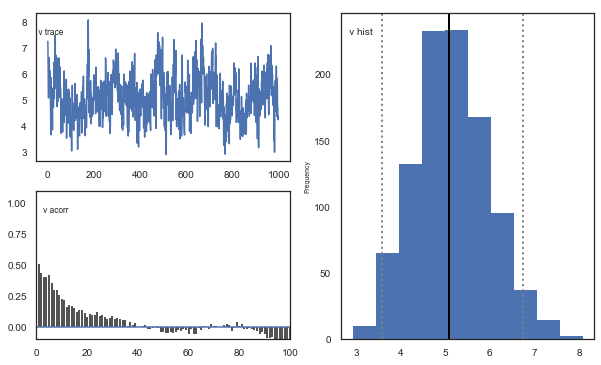
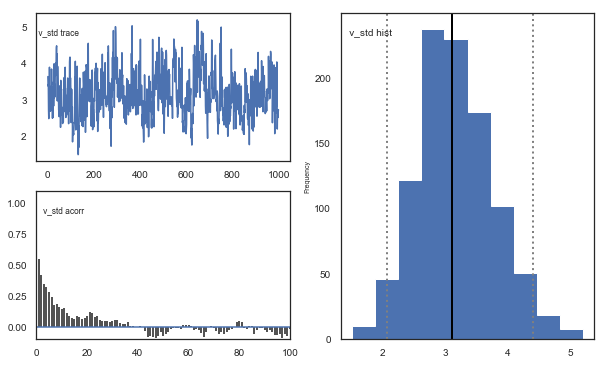
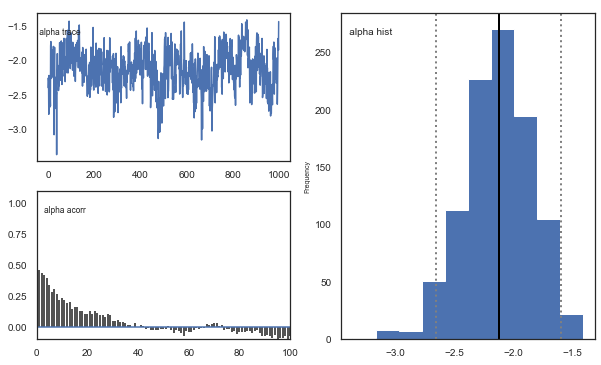
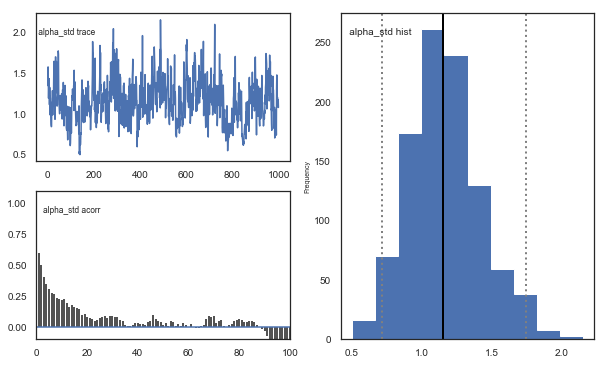
Fig. Mixing and autocorrelation looks good.
# estimate convergence
models = []
for i in range(3):
m = hddm.Hrl(data=data)
m.sample(1500, burn=500, dbname="traces.db", db="pickle")
models.append(m)
# get max gelman-statistic value. shouldn't be higher than 1.1
np.max(list(gelman_rubin(models).values()))
[-----------------100%-----------------] 1500 of 1500 complete in 48.7 sec
/Users/madslundpedersen/anaconda/envs/py36/lib/python3.6/site-packages/kabuki/analyze.py:148: FutureWarning:
.ix is deprecated. Please use
.loc for label based indexing or
.iloc for positional indexing
See the documentation here:
http://pandas.pydata.org/pandas-docs/stable/user_guide/indexing.html#ix-indexer-is-deprecated
samples[i,:] = model.nodes_db.ix[name, 'node'].trace()
/Users/madslundpedersen/anaconda/envs/py36/lib/python3.6/site-packages/pandas/core/indexing.py:961: FutureWarning:
.ix is deprecated. Please use
.loc for label based indexing or
.iloc for positional indexing
See the documentation here:
http://pandas.pydata.org/pandas-docs/stable/user_guide/indexing.html#ix-indexer-is-deprecated
return getattr(section, self.name)[new_key]
1.0244990742970825
Convergence looks good, i.e. no parameters with gelman-rubin statistic > 1.1.
# Create a new model that has all traces concatenated
# of individual models.
m_rl = kabuki.utils.concat_models(models)
alpha, v = m_rl.nodes_db.node[["alpha", "v"]]
samples = {"alpha": alpha.trace(), "v": v.trace()}
samp = pd.DataFrame(data=samples)
def corrfunc(x, y, **kws):
r, _ = stats.pearsonr(x, y)
ax = plt.gca()
ax.annotate("r = {:.2f}".format(r), xy=(0.1, 0.9), xycoords=ax.transAxes)
g = sns.PairGrid(samp, palette=["red"])
g.map_upper(plt.scatter, s=10)
g.map_diag(sns.distplot, kde=False)
g.map_lower(sns.kdeplot, cmap="Blues_d")
g.map_lower(corrfunc)
<seaborn.axisgrid.PairGrid at 0x12a9d21d0>

Fig. The correlation in the posterior distribution for alpha and v/scaling is somewhat negative.
Posterior predictive check
We can also do posterior predictive check on the RL-model by generating new data with hddm.generate.gen_rand_rl_data.
# create empty dataframe to store simulated data
sim_data = pd.DataFrame()
# create a column samp to be used to identify the simulated data sets
data["samp"] = 0
# load traces
traces = m_rl.get_traces()
# decide how many times to repeat simulation process. repeating this multiple times is generally recommended as it better captures the uncertainty in the posterior distribution, but will also take some time
for i in tqdm(range(1, 51)):
# randomly select a row in the traces to use for extracting parameter values
sample = np.random.randint(0, traces.shape[0] - 1)
# loop through all subjects in observed data
for s in data.subj_idx.unique():
# get number of trials for each condition.
size0 = len(
data[(data["subj_idx"] == s) & (data["split_by"] == 0)].trial.unique()
)
size1 = len(
data[(data["subj_idx"] == s) & (data["split_by"] == 1)].trial.unique()
)
size2 = len(
data[(data["subj_idx"] == s) & (data["split_by"] == 2)].trial.unique()
)
# set parameter values for simulation
scaler = traces.loc[sample, "v_subj." + str(s)]
alphaInv = traces.loc[sample, "alpha_subj." + str(s)]
# take inverse logit of estimated alpha
alpha = np.exp(alphaInv) / (1 + np.exp(alphaInv))
# simulate data for each condition changing only values of size, p_upper, p_lower and split_by between conditions.
sim_data0 = hddm.generate.gen_rand_rl_data(
scaler=scaler, alpha=alpha, size=size0, p_upper=0.8, p_lower=0.2, split_by=0
)
sim_data1 = hddm.generate.gen_rand_rl_data(
scaler=scaler, alpha=alpha, size=size1, p_upper=0.7, p_lower=0.3, split_by=1
)
sim_data2 = hddm.generate.gen_rand_rl_data(
scaler=scaler, alpha=alpha, size=size2, p_upper=0.6, p_lower=0.4, split_by=2
)
# append the conditions
sim_data0 = sim_data0.append([sim_data1, sim_data2], ignore_index=True)
# assign subj_idx
sim_data0["subj_idx"] = s
# identify that these are simulated data
sim_data0["type"] = "simulated"
# identify the simulated data
sim_data0["samp"] = i
# append data from each subject
sim_data = sim_data.append(sim_data0, ignore_index=True)
# combine observed and simulated data
ppc_rl_data = data[
["subj_idx", "response", "split_by", "trial", "feedback", "samp"]
].copy()
ppc_rl_data["type"] = "observed"
ppc_rl_sdata = sim_data[
["subj_idx", "response", "split_by", "trial", "feedback", "type", "samp"]
].copy()
ppc_rl_data = ppc_rl_data.append(ppc_rl_sdata)
100%|██████████| 50/50 [12:53<00:00, 15.47s/it]
/Users/madslundpedersen/anaconda/envs/py36/lib/python3.6/site-packages/pandas/core/frame.py:7138: FutureWarning: Sorting because non-concatenation axis is not aligned. A future version
of pandas will change to not sort by default.
To accept the future behavior, pass 'sort=False'.
To retain the current behavior and silence the warning, pass 'sort=True'.
sort=sort,
# for practical reasons we only look at the first 40 trials for each subject in a given condition
plot_ppc_rl_data = ppc_rl_data[ppc_rl_data.trial < 41].copy()
# bin trials to for smoother estimate of response proportion across learning
plot_ppc_rl_data["bin_trial"] = pd.cut(
plot_ppc_rl_data.trial, 11, labels=np.linspace(0, 10, 11)
).astype("int64")
# calculate means for each sample
sums = (
plot_ppc_rl_data.groupby(["bin_trial", "split_by", "samp", "type"])
.mean()
.reset_index()
)
# calculate the overall mean response across samples
ppc_rl_sim = sums.groupby(["bin_trial", "split_by", "type"]).mean().reset_index()
# initiate columns that will have the upper and lower bound of the hpd
ppc_rl_sim["upper_hpd"] = 0
ppc_rl_sim["lower_hpd"] = 0
for i in range(0, ppc_rl_sim.shape[0]):
# calculate the hpd/hdi of the predicted mean responses across bin_trials
hdi = pymc.utils.hpd(
sums.response[
(sums["bin_trial"] == ppc_rl_sim.bin_trial[i])
& (sums["split_by"] == ppc_rl_sim.split_by[i])
& (sums["type"] == ppc_rl_sim.type[i])
],
alpha=0.1,
)
ppc_rl_sim.loc[i, "upper_hpd"] = hdi[1]
ppc_rl_sim.loc[i, "lower_hpd"] = hdi[0]
# calculate error term as the distance from upper bound to mean
ppc_rl_sim["up_err"] = ppc_rl_sim["upper_hpd"] - ppc_rl_sim["response"]
ppc_rl_sim["low_err"] = ppc_rl_sim["response"] - ppc_rl_sim["lower_hpd"]
ppc_rl_sim["model"] = "RL"
# plotting evolution of choice proportion for best option across learning for observed and simulated data. Compared for RL and RLDDM models, both with single learnign rate.
fig, axs = plt.subplots(figsize=(15, 5), nrows=1, ncols=3, sharex=True, sharey=True)
for i in range(0, 3):
ax = axs[i]
d_single = ppc_sim[(ppc_sim.split_by == i) & (ppc_sim.type == "simulated")]
# slightly move bin_trial to avoid overlap in errorbars
d_single["bin_trial"] += 0.2
ax.errorbar(
d_single.bin_trial,
d_single.response,
yerr=[d_single.low_err, d_single.up_err],
label="simulated_RLDDM",
color="orange",
)
ax = axs[i]
d_rl = ppc_rl_sim[(ppc_rl_sim.split_by == i) & (ppc_rl_sim.type == "simulated")]
ax.errorbar(
d_rl.bin_trial,
d_rl.response,
yerr=[d_rl.low_err, d_rl.up_err],
label="simulated_RL",
color="green",
)
ax = axs[i]
d = ppc_sim[(ppc_dual_sim.split_by == i) & (ppc_dual_sim.type == "observed")]
ax.plot(d.bin_trial, d.response, linewidth=3, label="observed")
ax.set_title("split_by = %i" % i, fontsize=20)
ax.set_ylabel("mean response")
ax.set_xlabel("trial")
plt.xlim(-0.5, 10.5)
plt.legend()
/Users/madslundpedersen/anaconda/envs/py36/lib/python3.6/site-packages/ipykernel/__main__.py:7: SettingWithCopyWarning:
A value is trying to be set on a copy of a slice from a DataFrame.
Try using .loc[row_indexer,col_indexer] = value instead
See the caveats in the documentation: http://pandas.pydata.org/pandas-docs/stable/user_guide/indexing.html#returning-a-view-versus-a-copy
<matplotlib.legend.Legend at 0x128cb23c8>
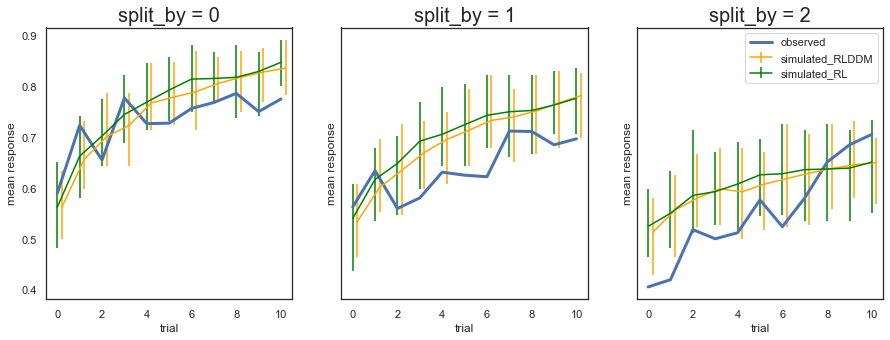
Fig. The predicted choice for the RL-model is very similar to what was predicted in the RLDDM. That is not surprising given that they use the same calculation to get the choice likelihood. The difference between them is instead that the RLDDM could potentially detect the unique contribution of the scaling/drift parameter and the decision threshold onto choice.
Misprediction across learning
Another way to visualize this is to look at how the predicted choice misses on the observed across learning, i.e. predicted-observed. As for the other plots we see that the two methods are very similar.
# rl
error_prediction = (
plot_ppc_rl_data.groupby(["split_by", "type", "bin_trial"])["response"]
.mean()
.reset_index()
)
ep = error_prediction.pivot_table(
index=["split_by", "bin_trial"], columns="type", values="response"
).reset_index()
ep["diff"] = ep["simulated"] - ep["observed"]
ep["model"] = "RL"
# rlddm
error_prediction = (
plot_ppc_data.groupby(["split_by", "type", "bin_trial"])["response"]
.mean()
.reset_index()
)
ep_rlddm = error_prediction.pivot_table(
index=["split_by", "bin_trial"], columns="type", values="response"
).reset_index()
ep_rlddm["diff"] = ep_rlddm["simulated"] - ep_rlddm["observed"]
ep_rlddm["model"] = "RLDDM"
# combine
ep = ep.append(ep_rlddm)
# plot
g = sns.relplot(
x="bin_trial",
y="diff",
col="split_by",
hue="model",
kind="line",
ci=False,
data=ep,
palette="Set2_r",
)
g.map(plt.axhline, y=0, ls=":", c=".5")
<seaborn.axisgrid.FacetGrid at 0x128b8f240>
